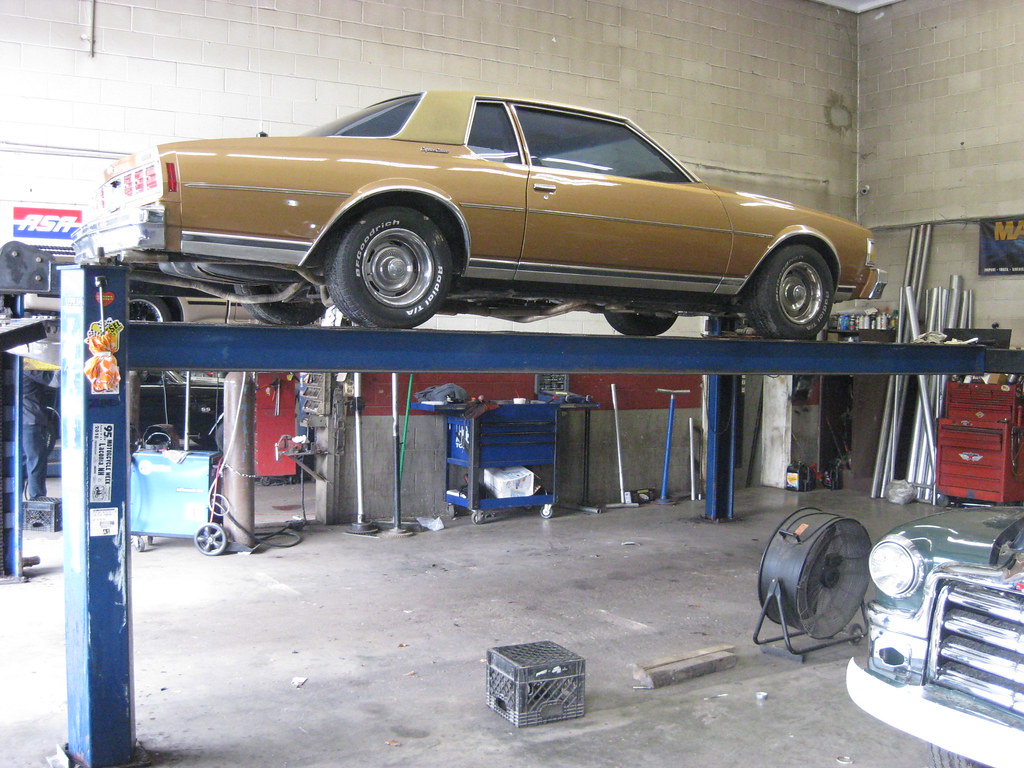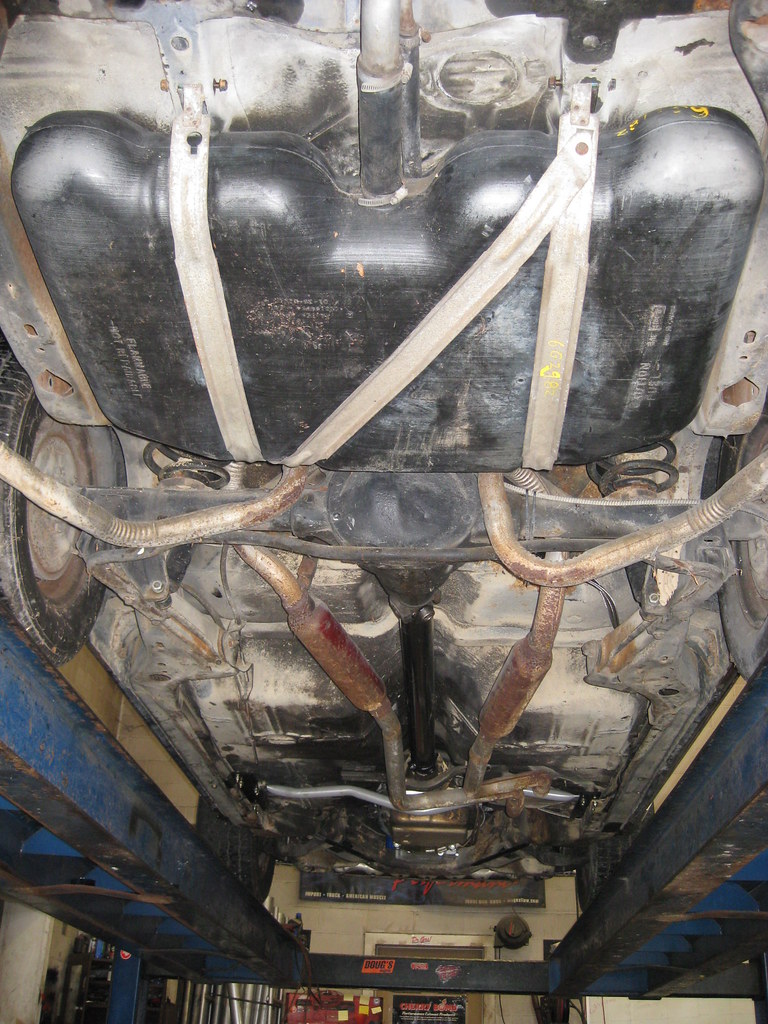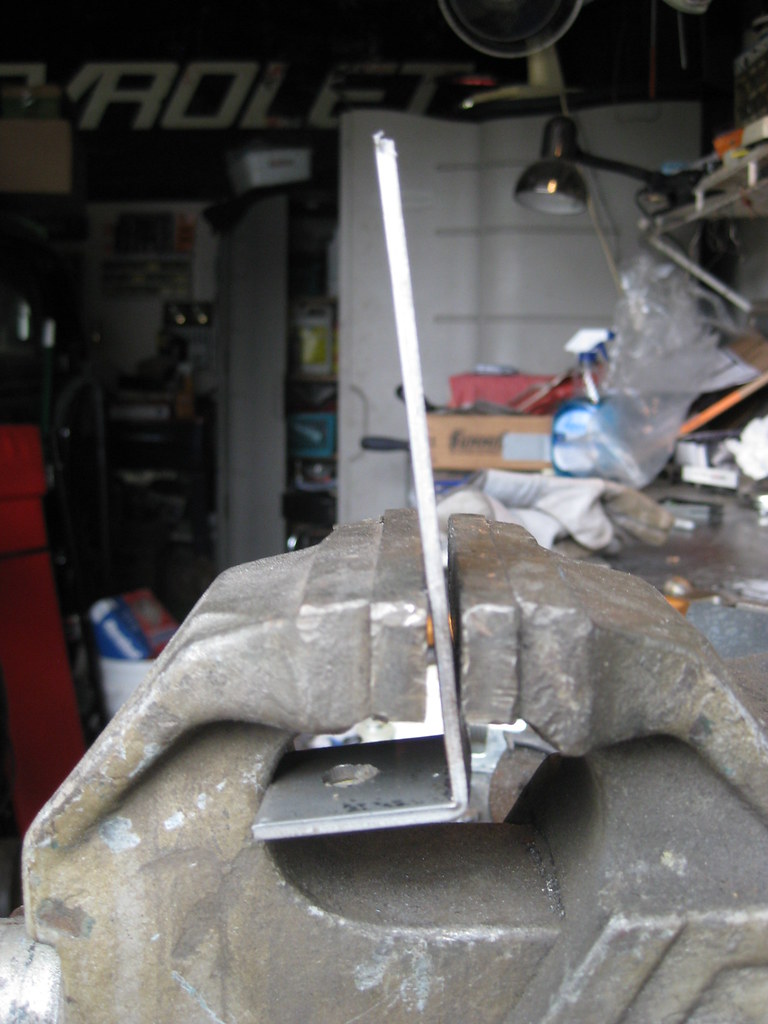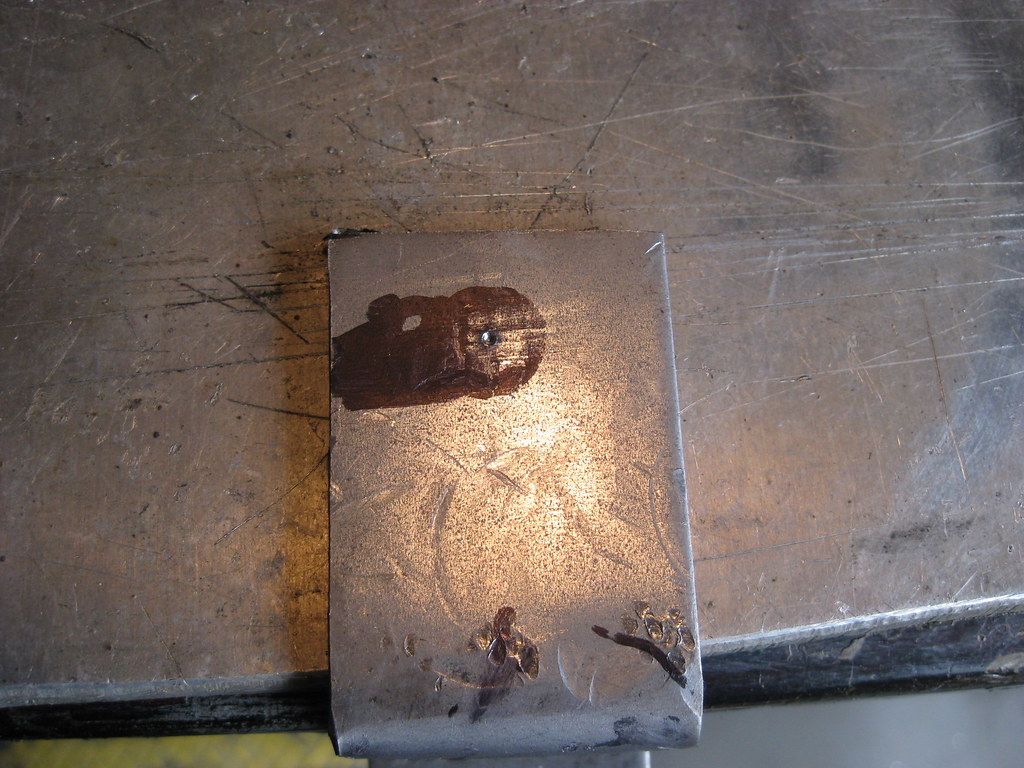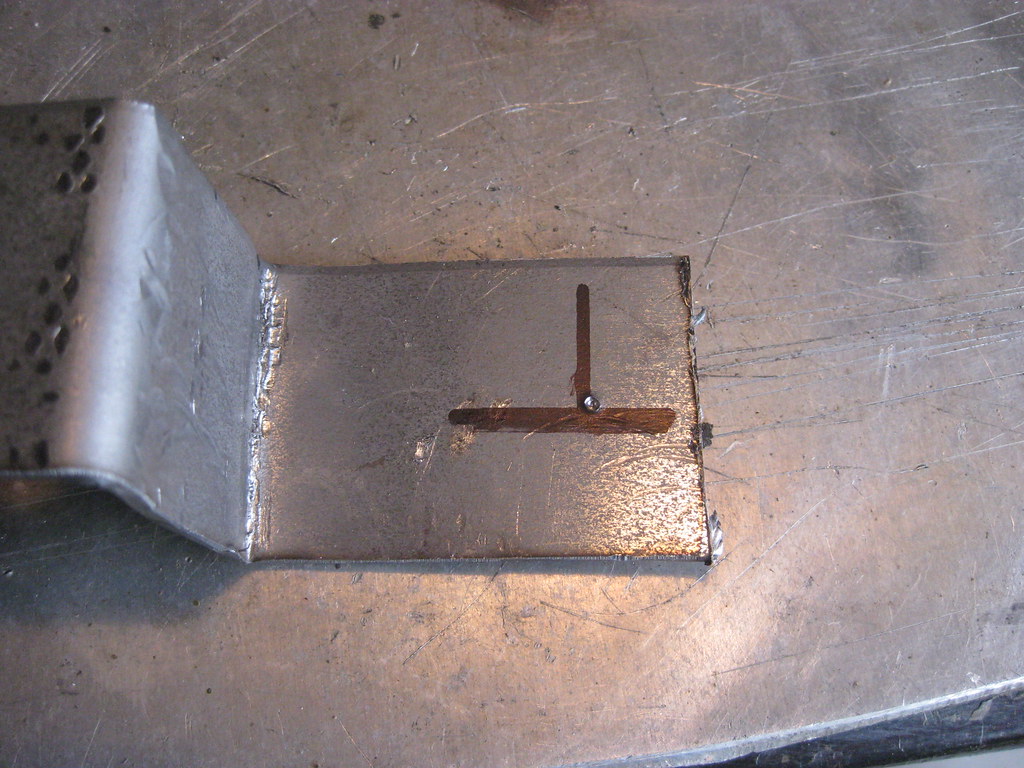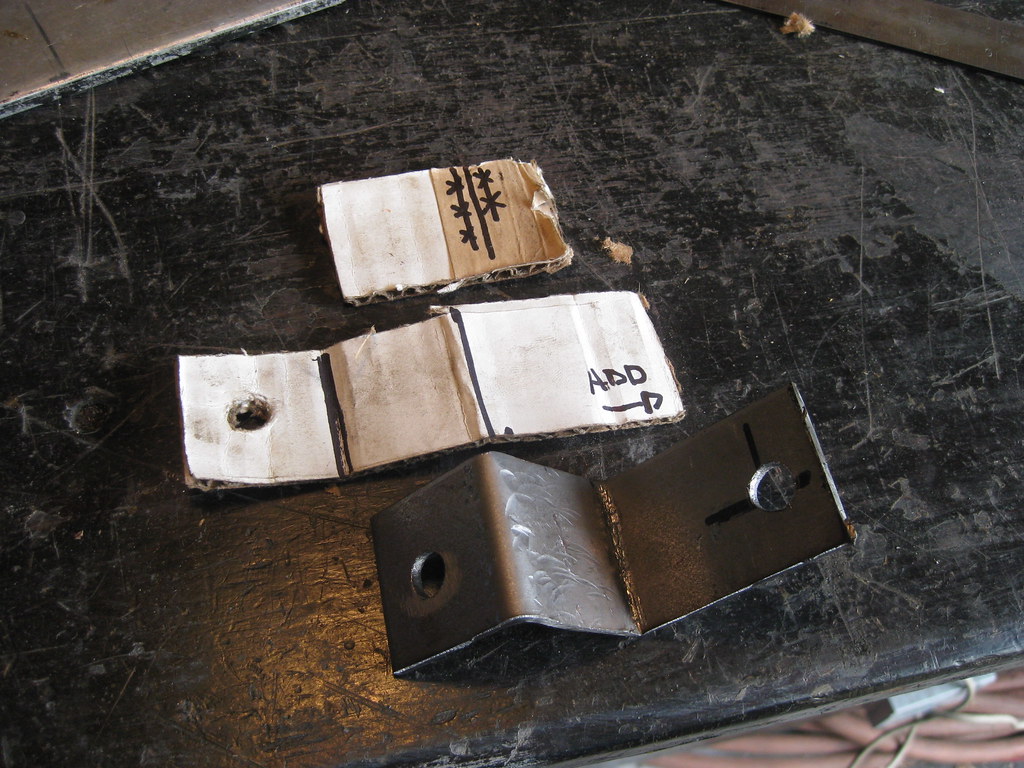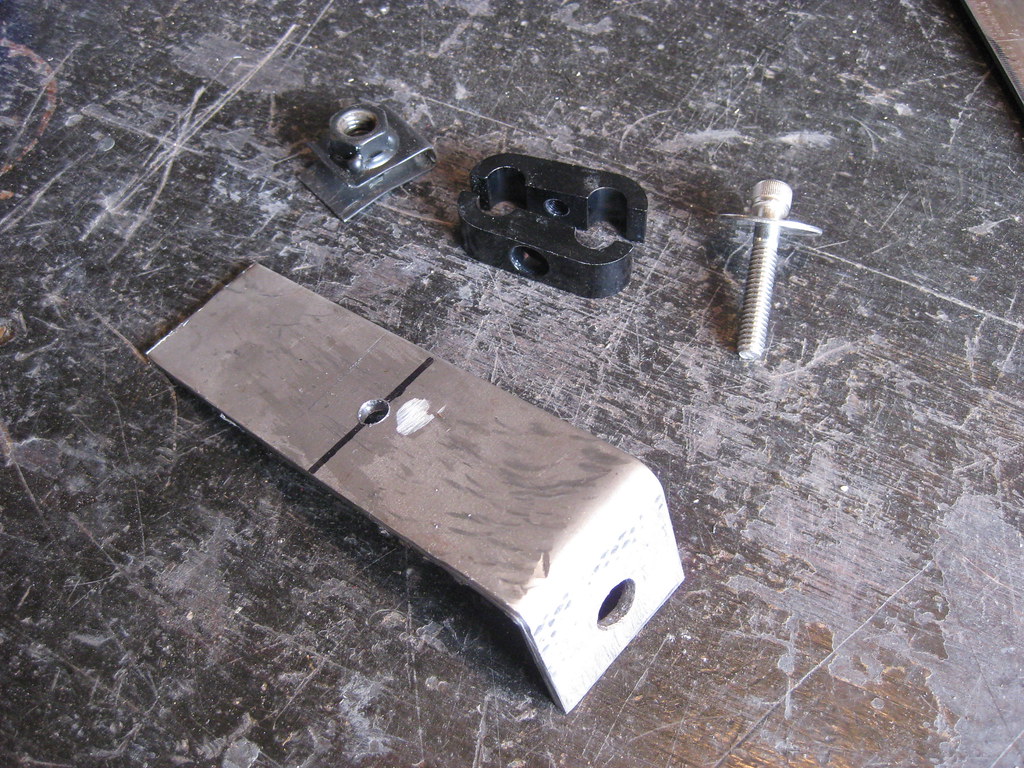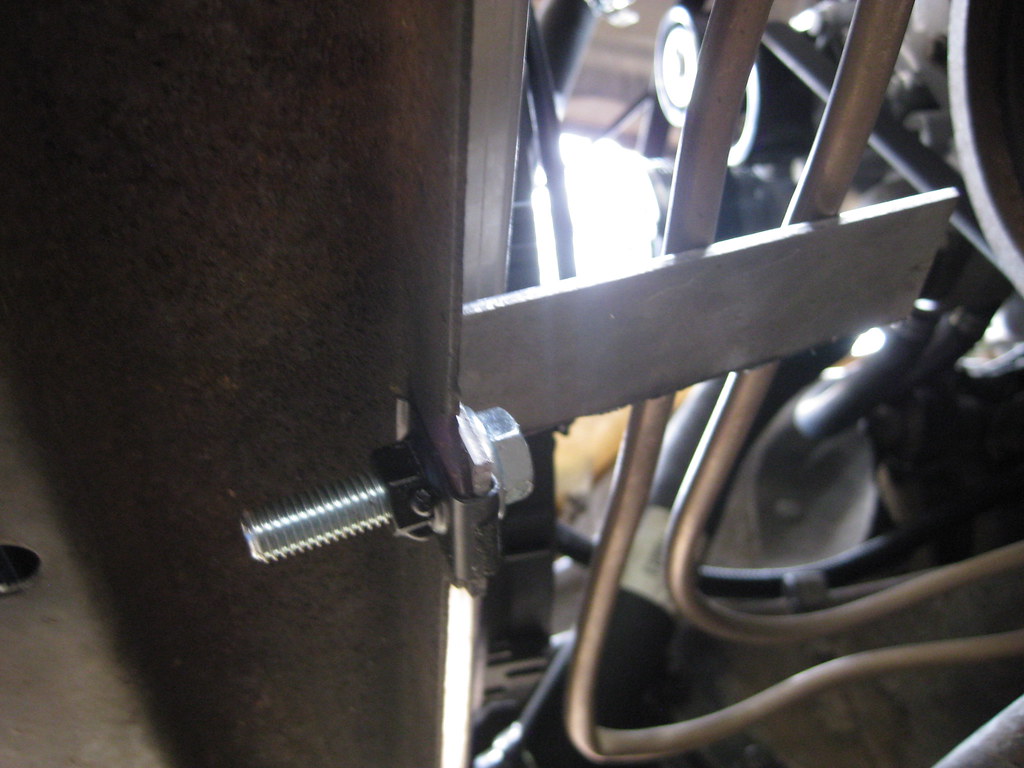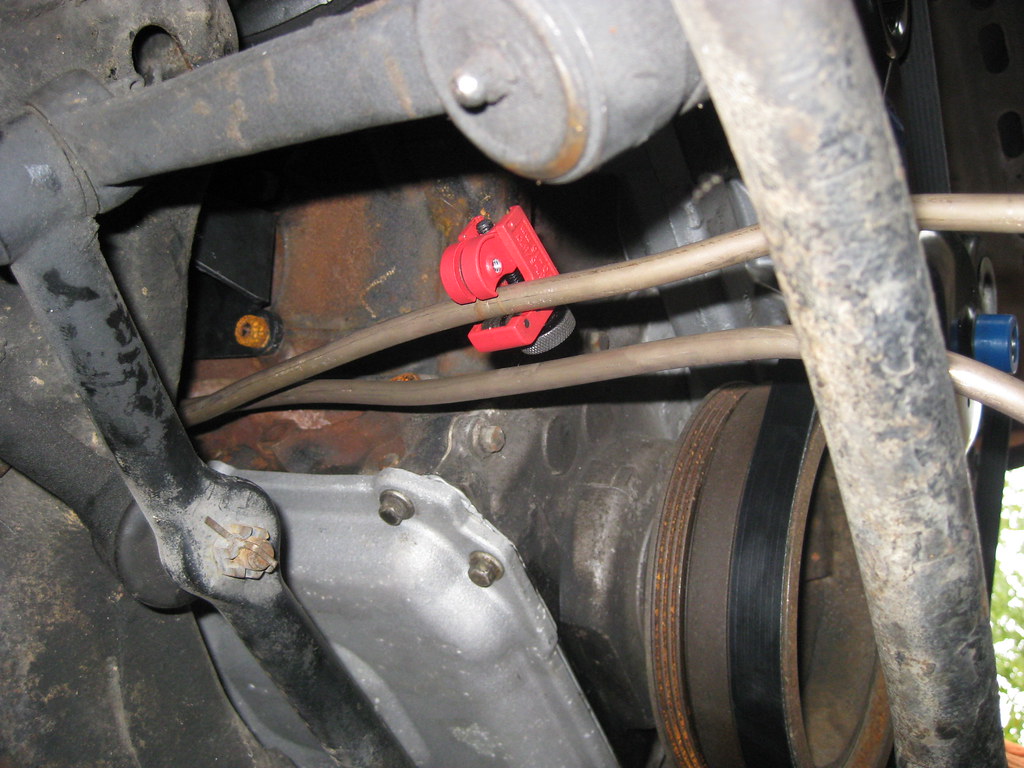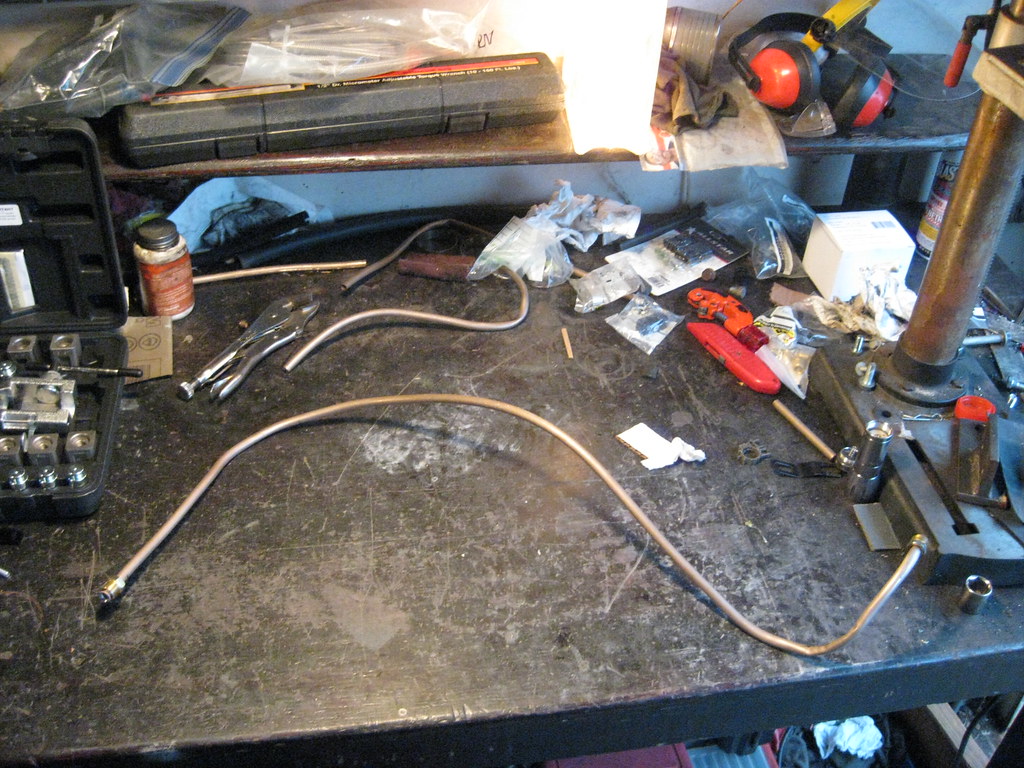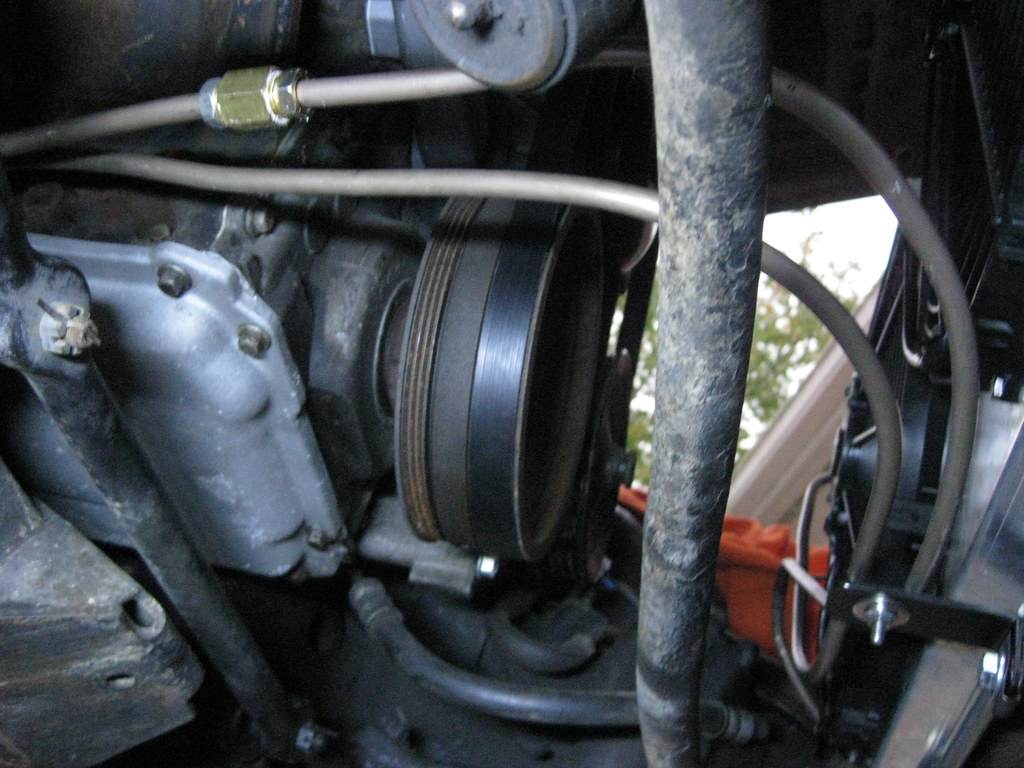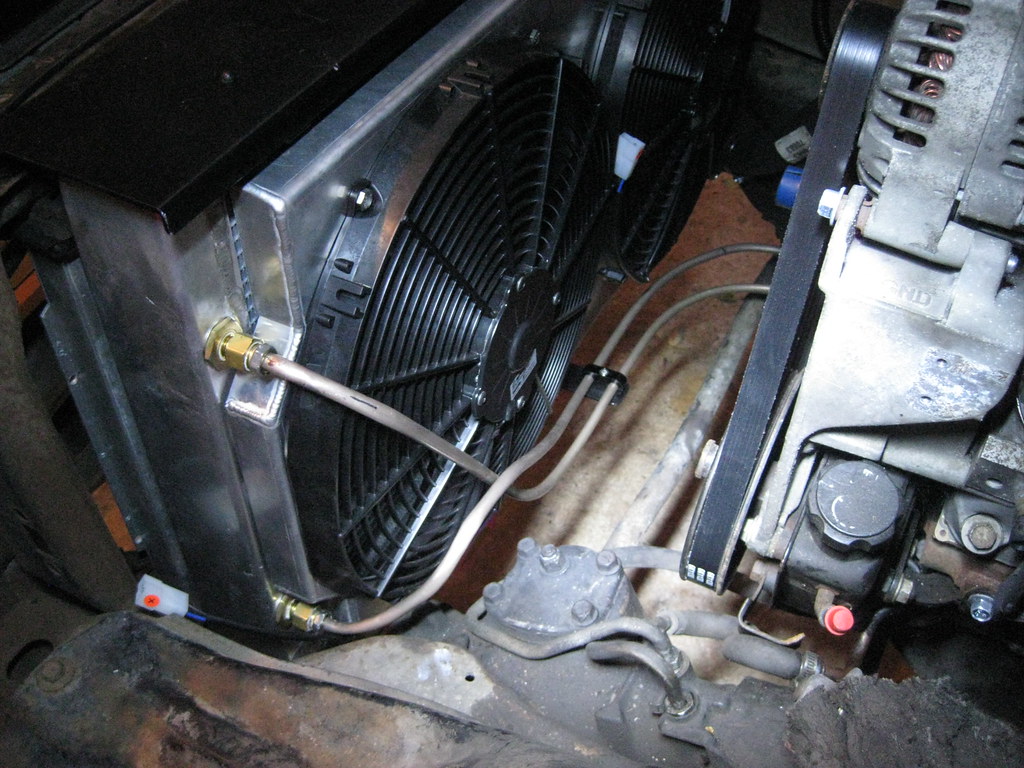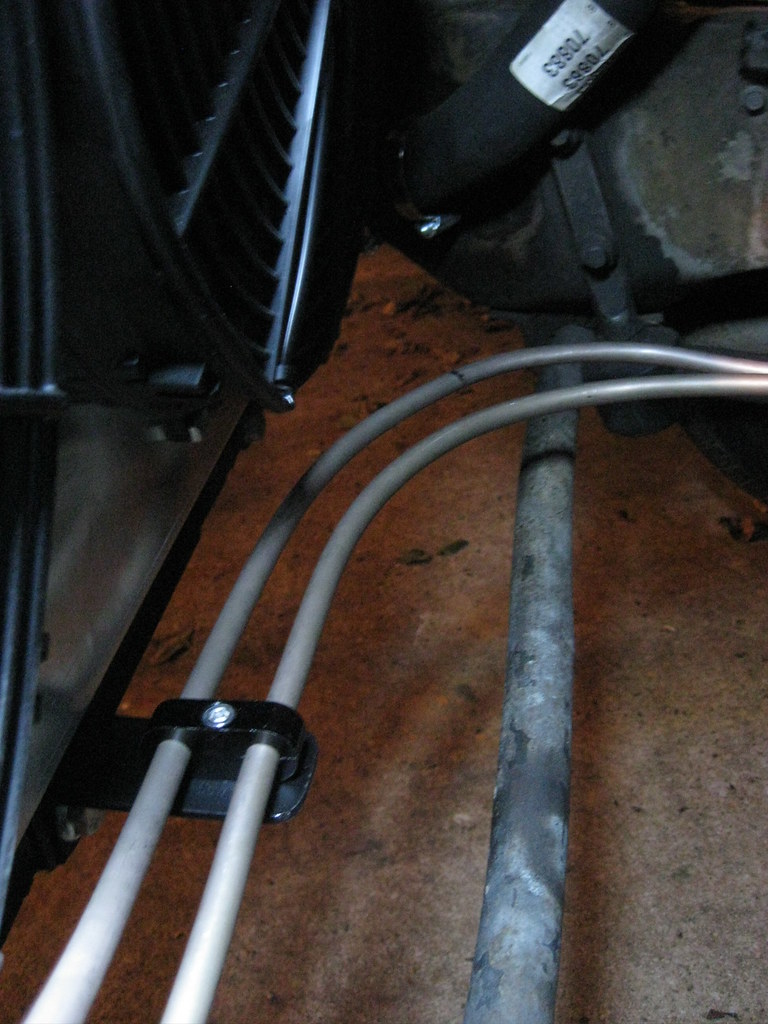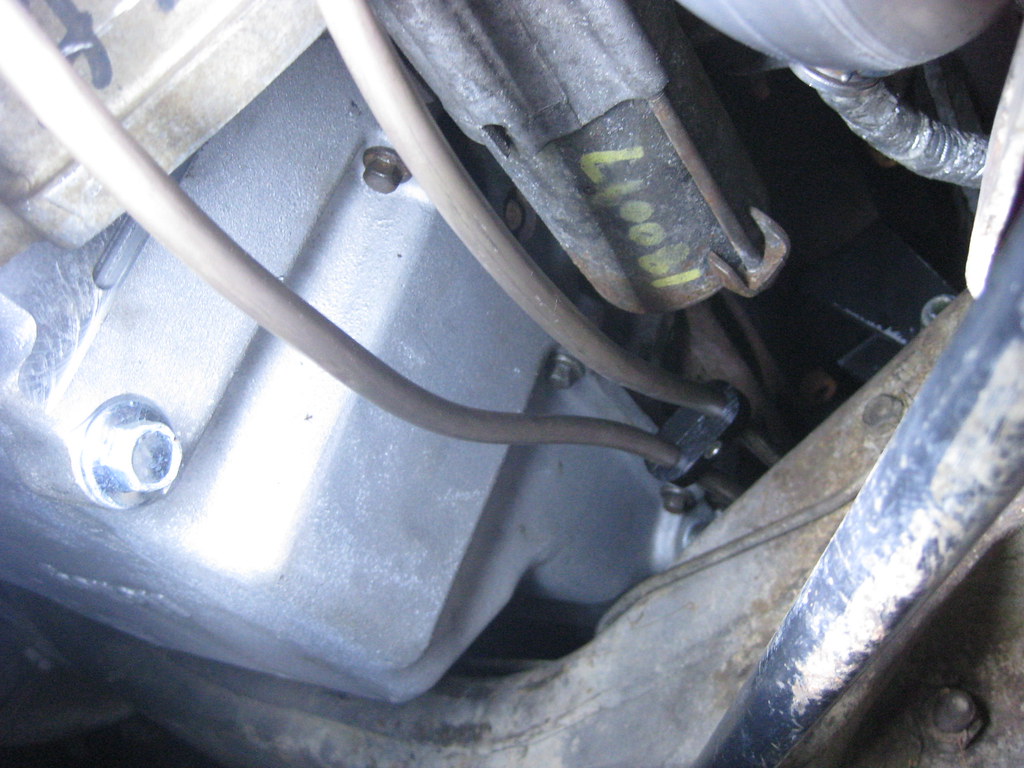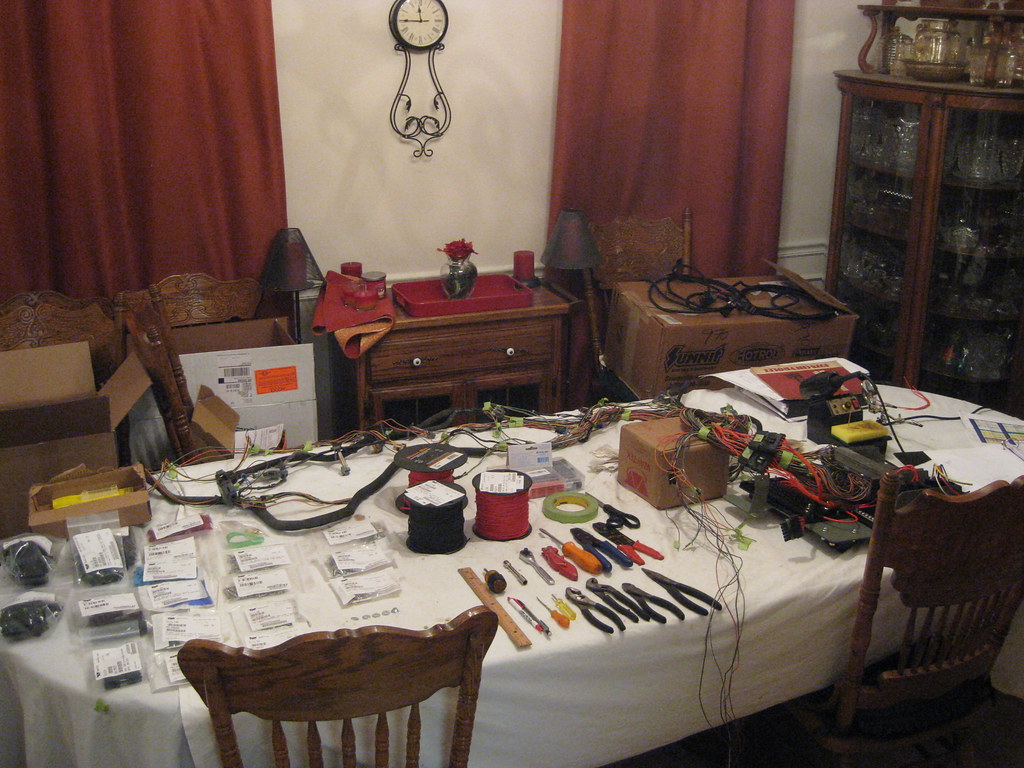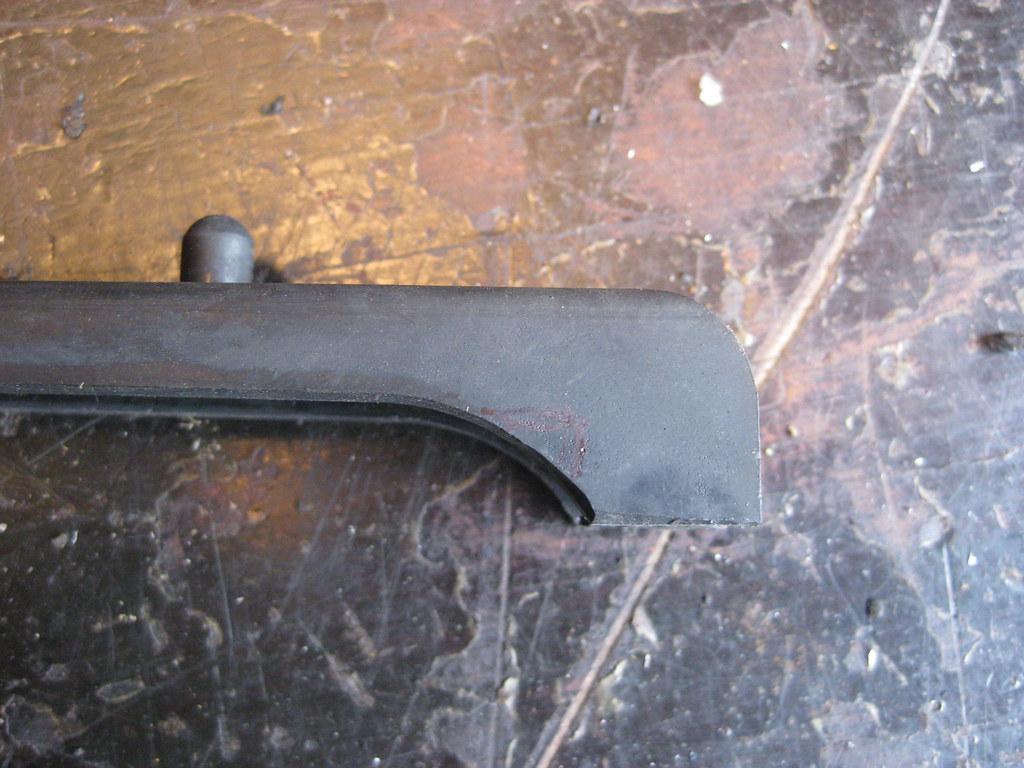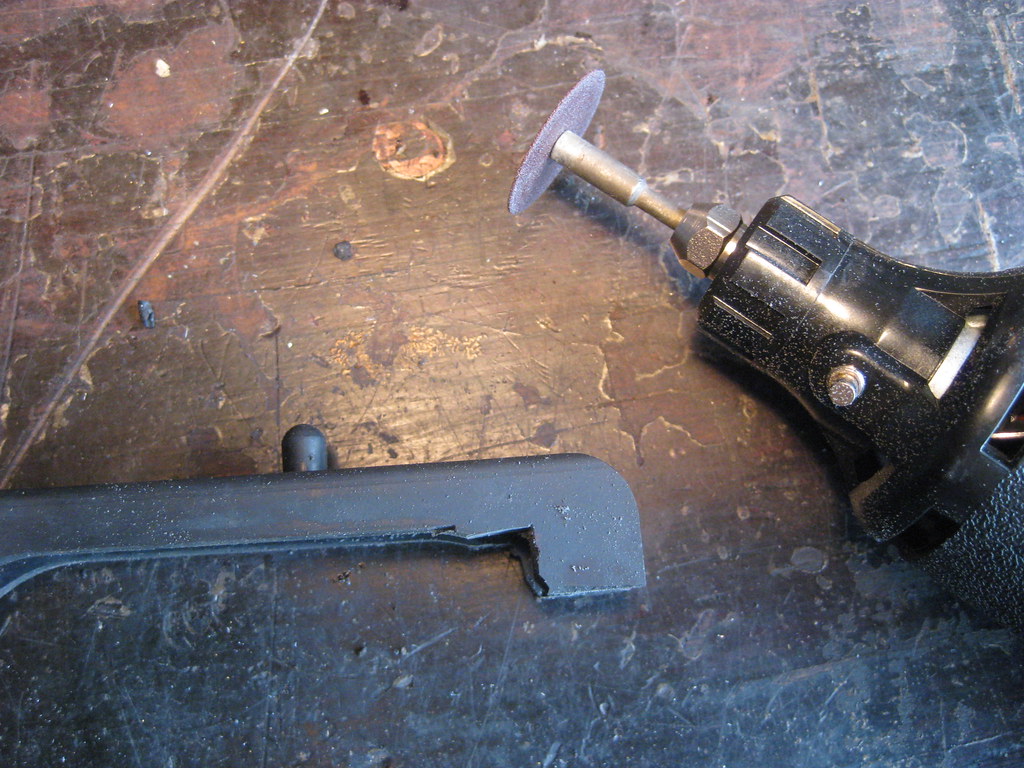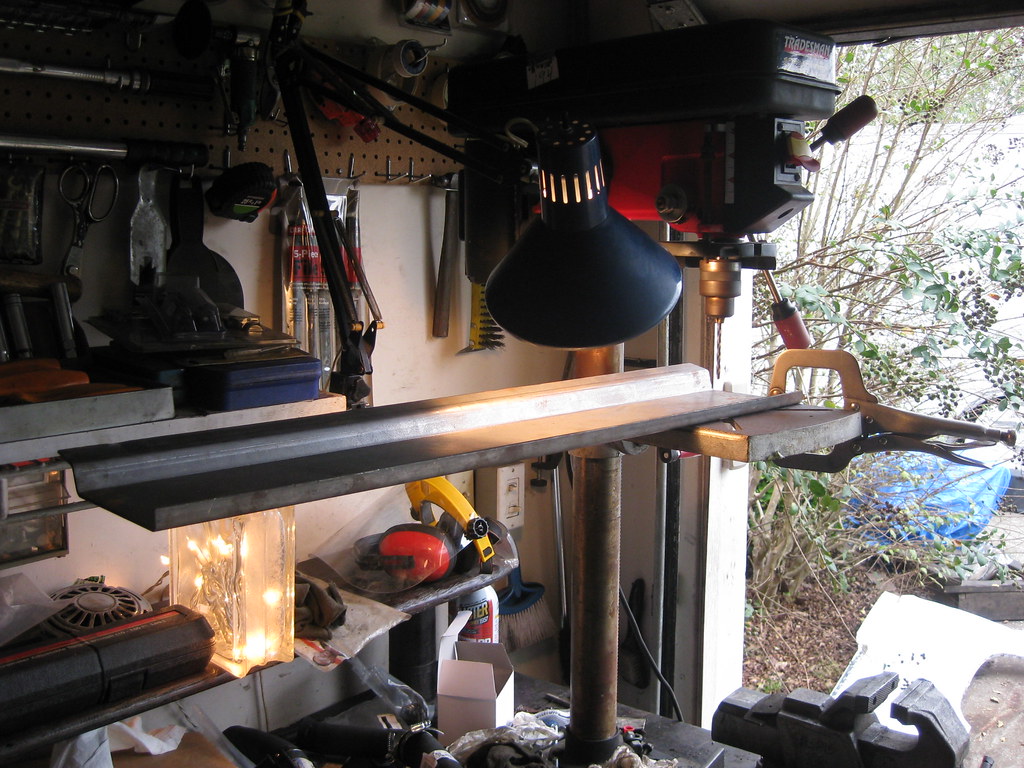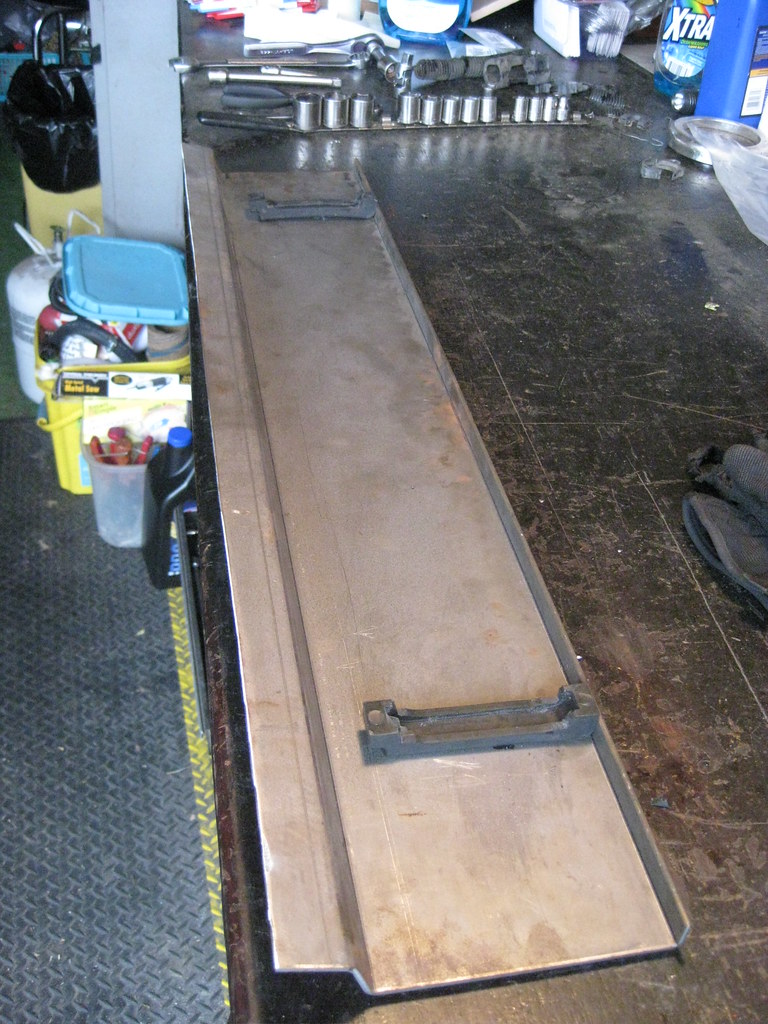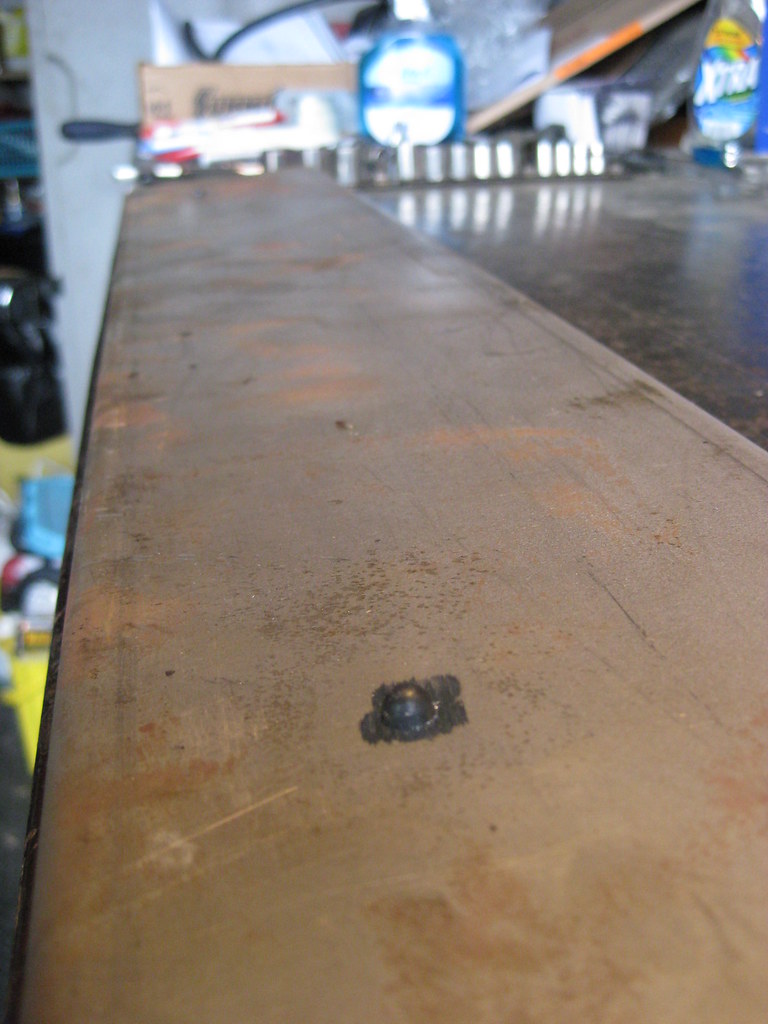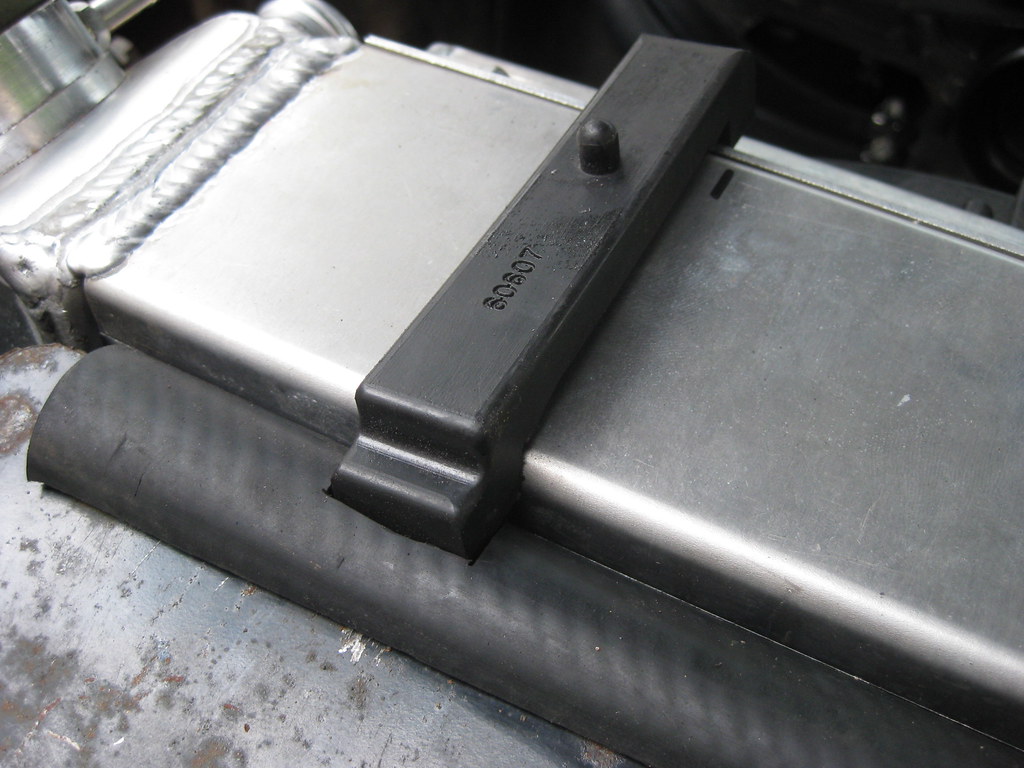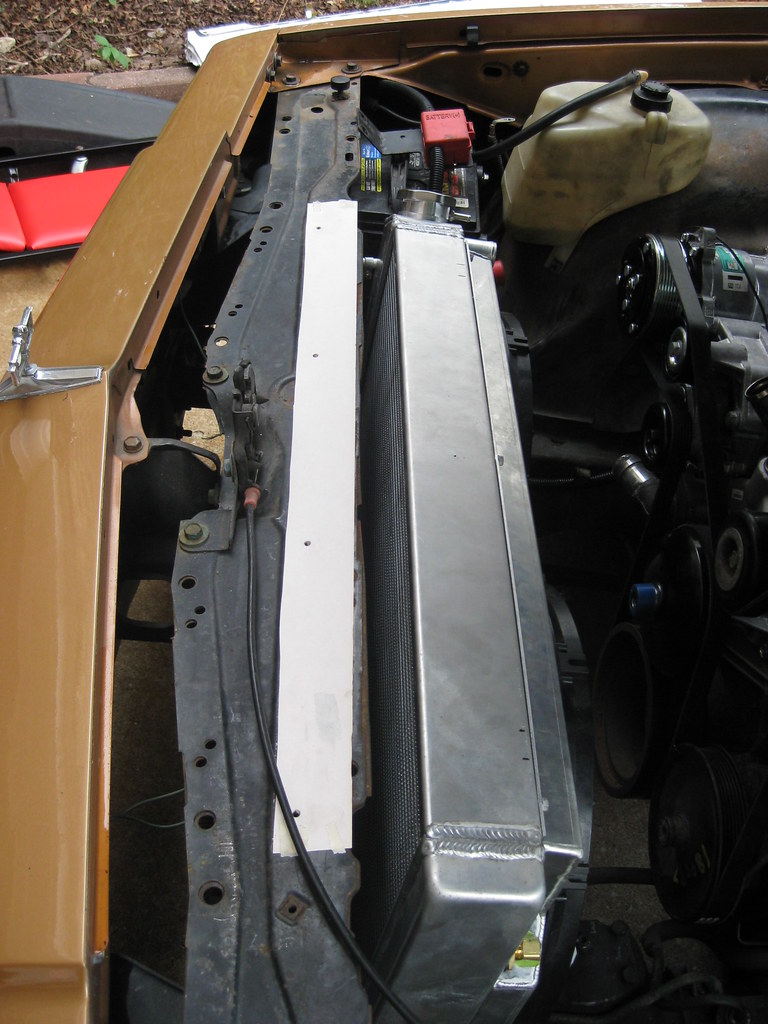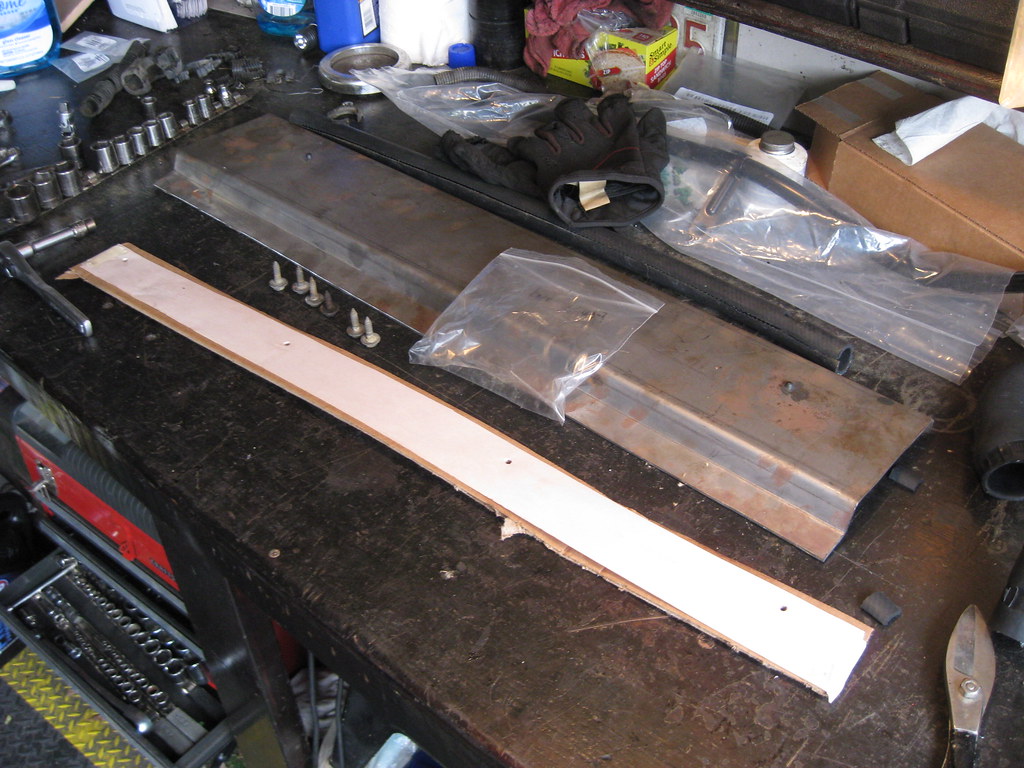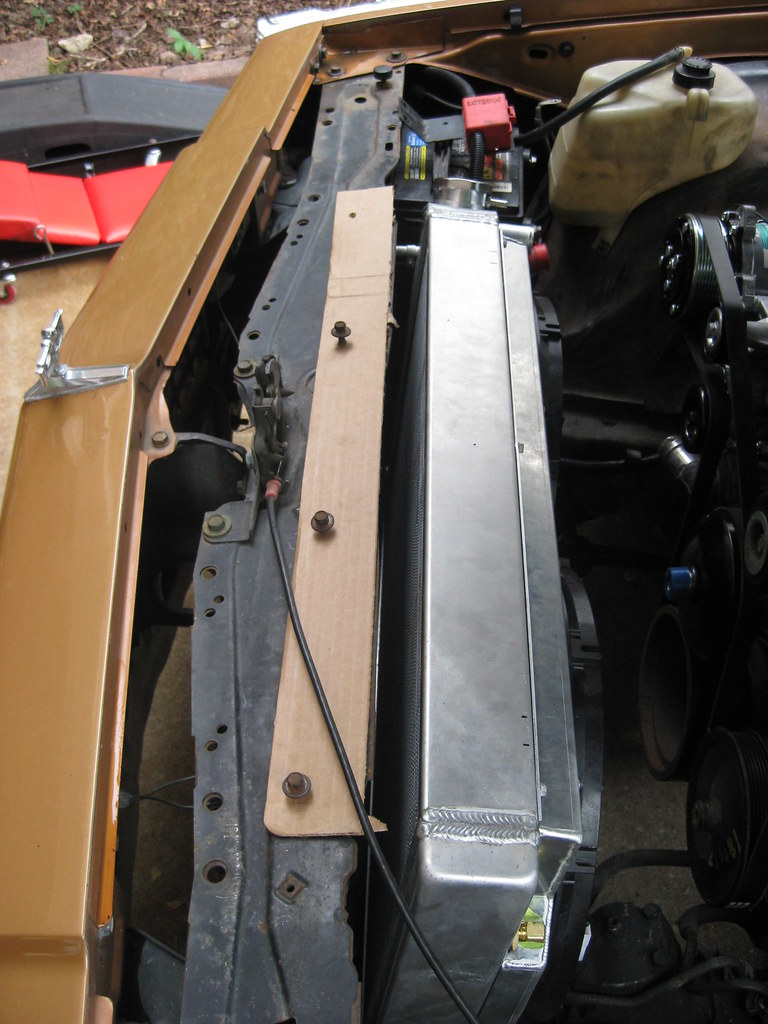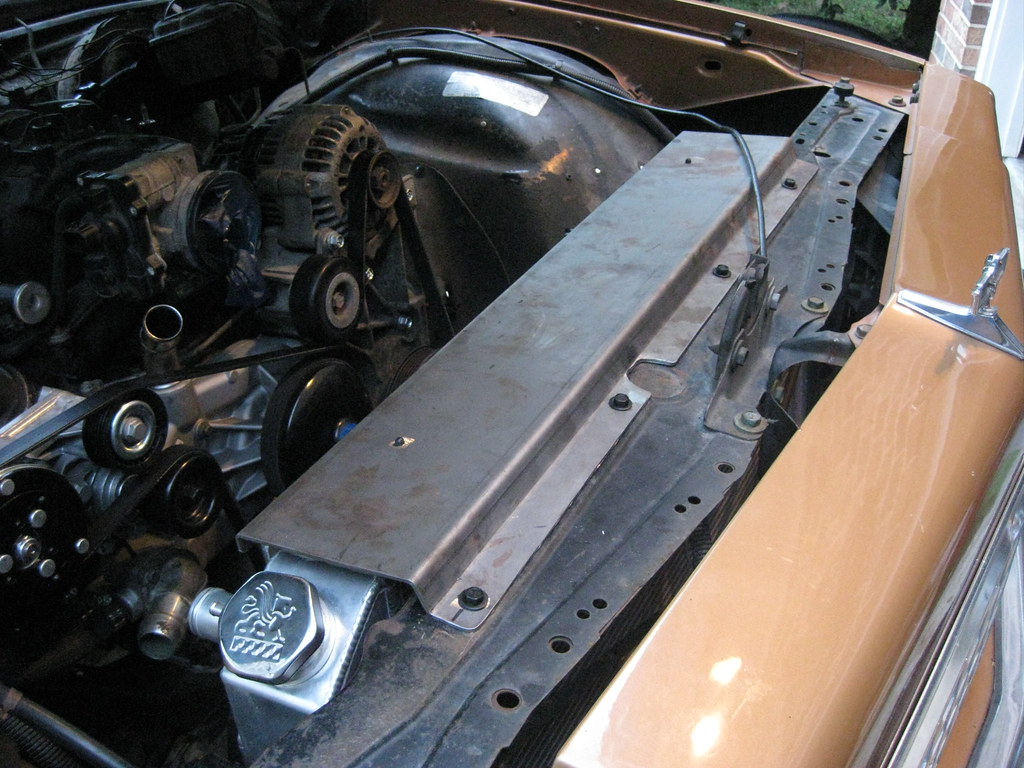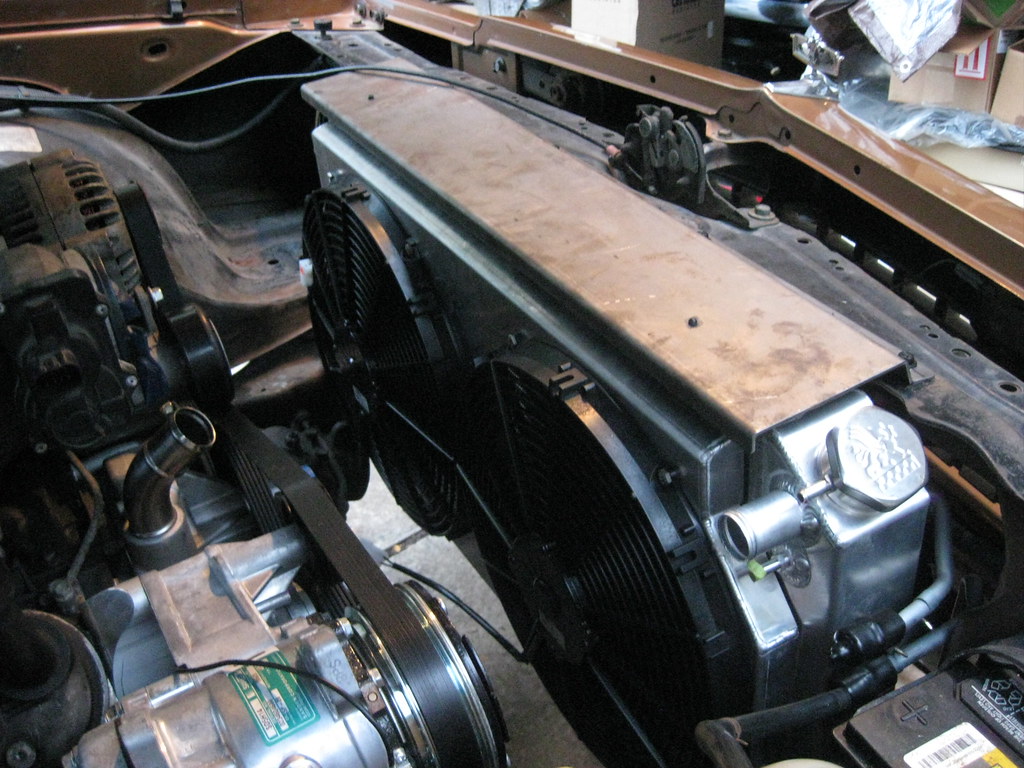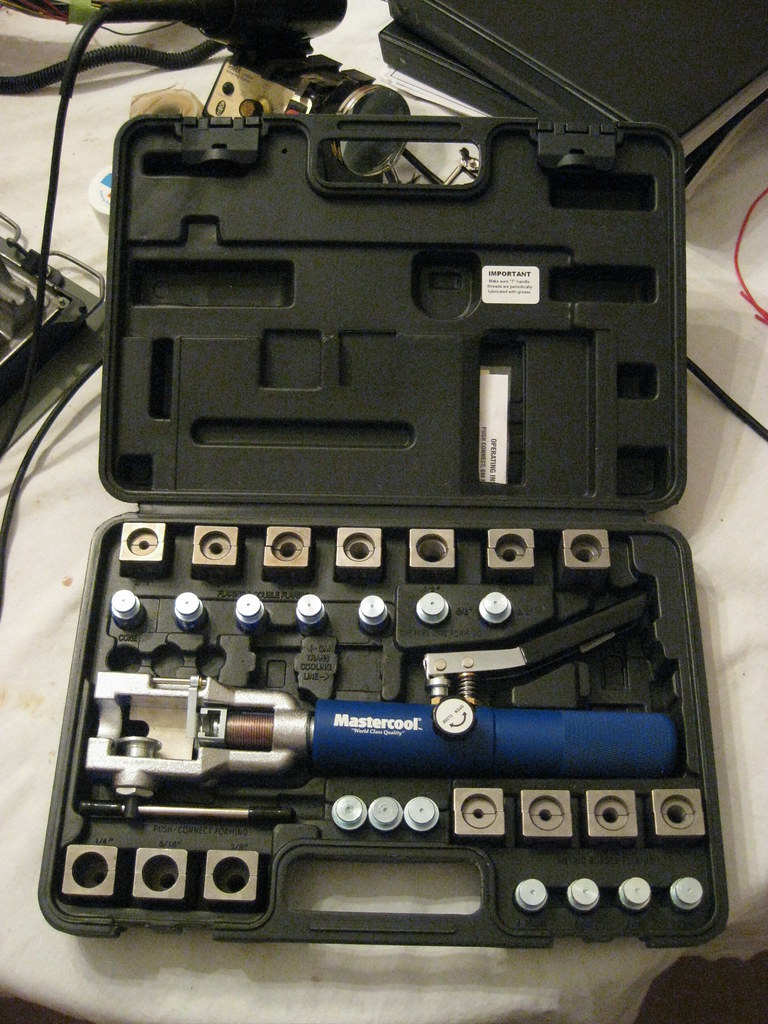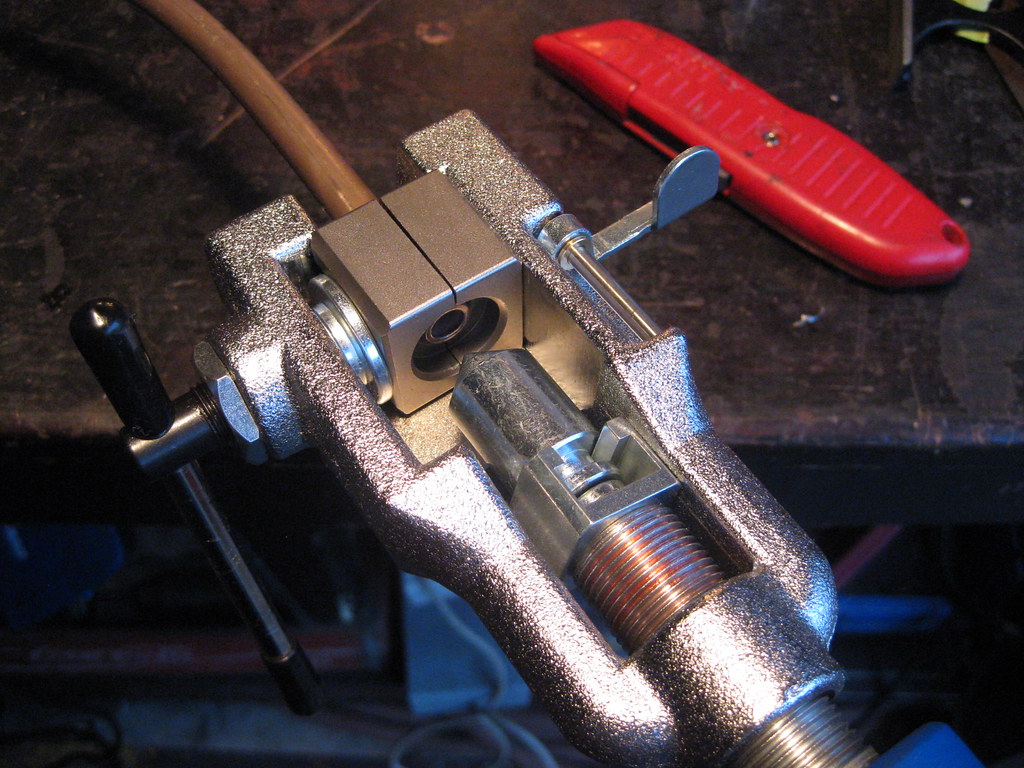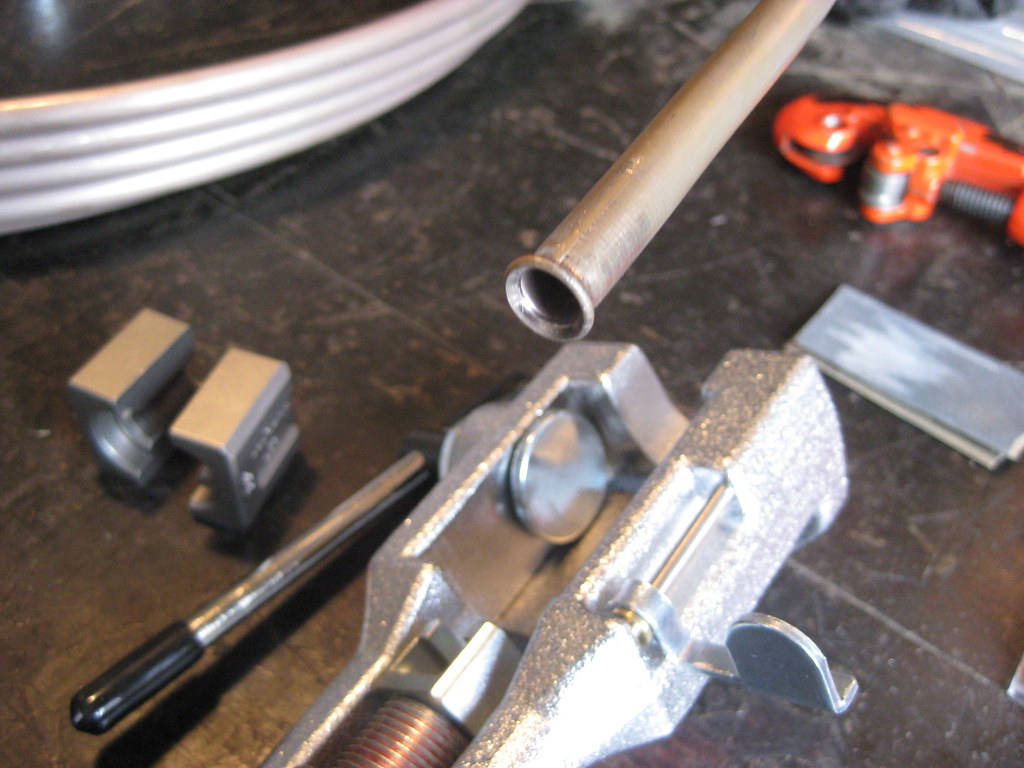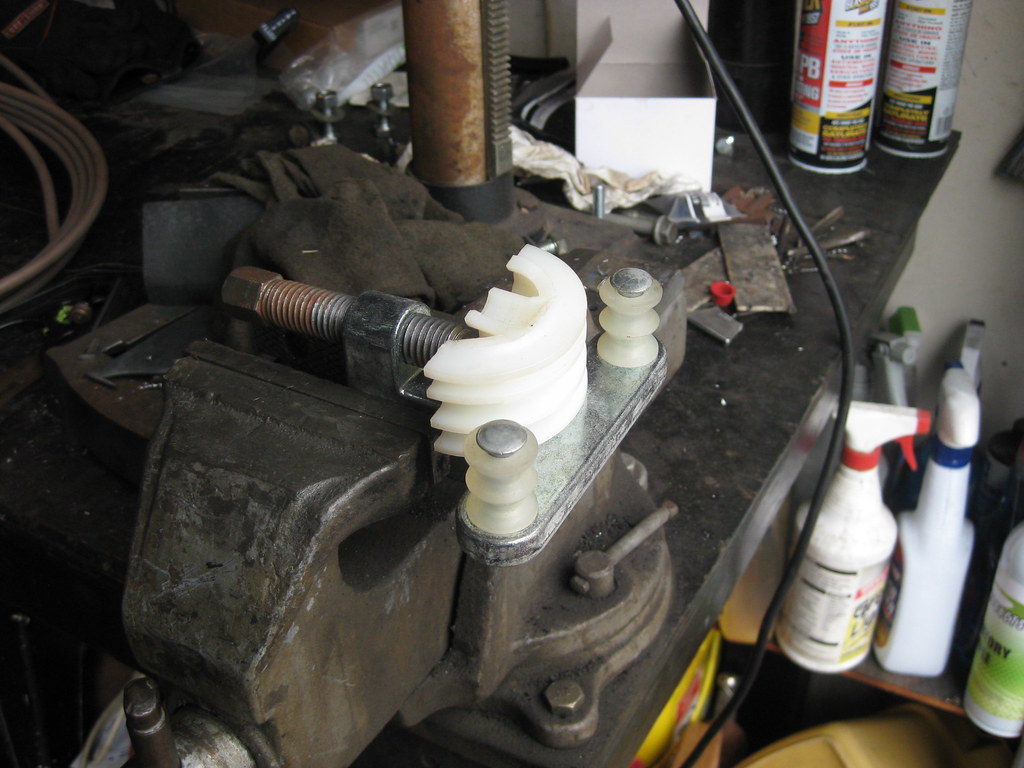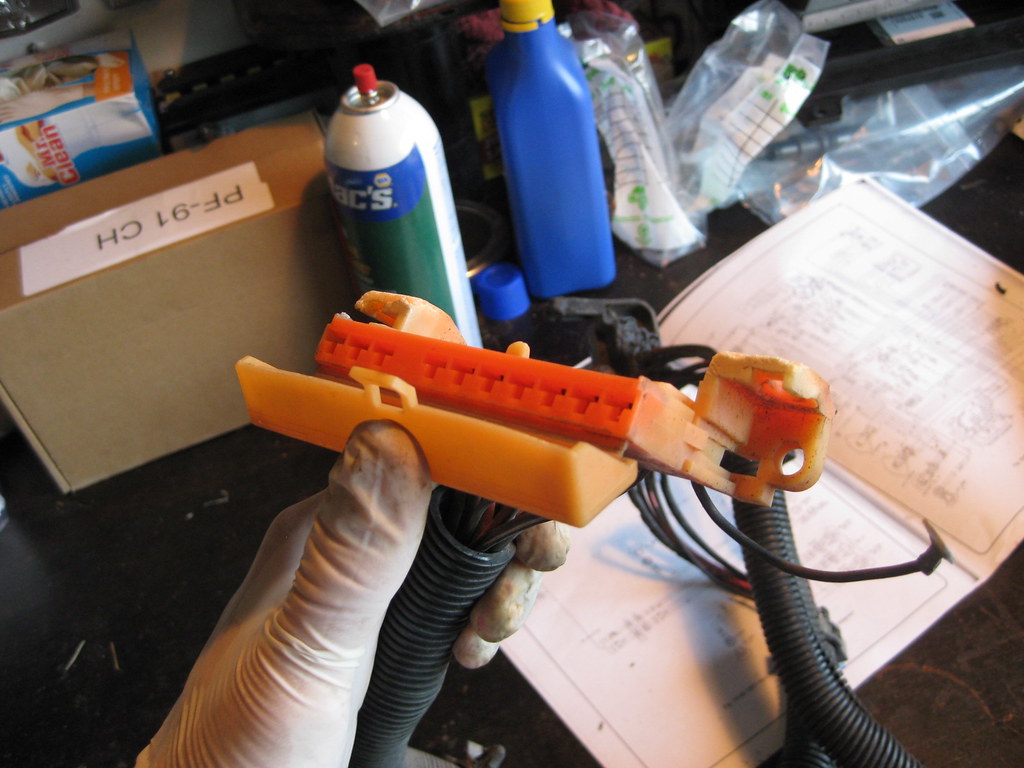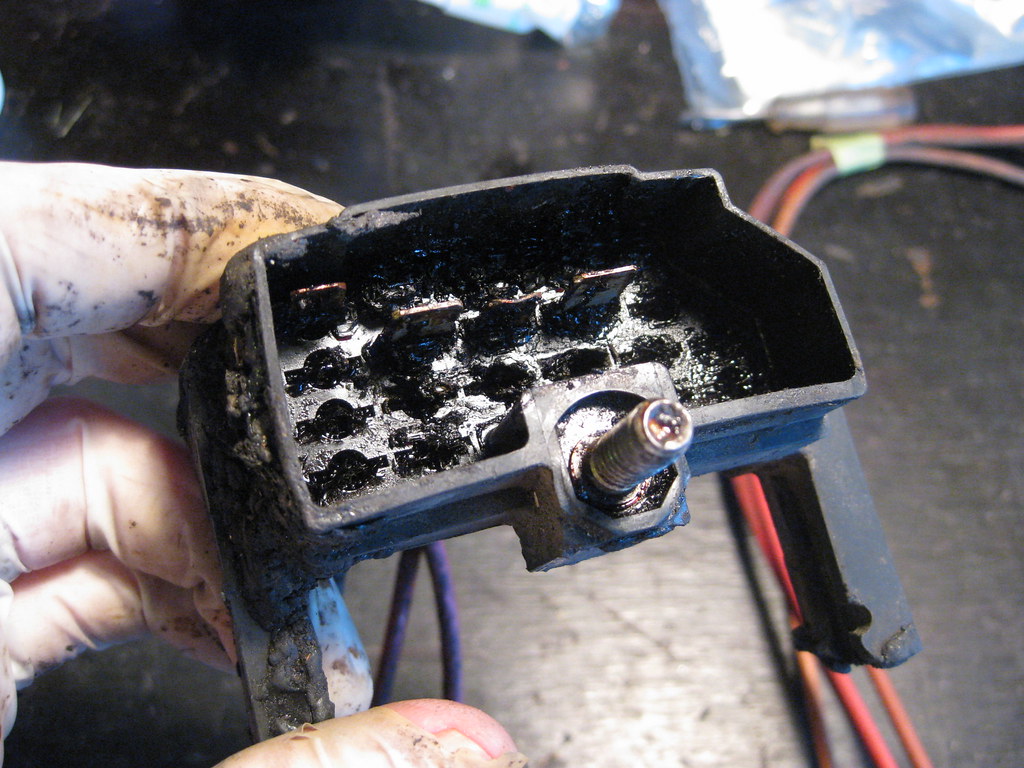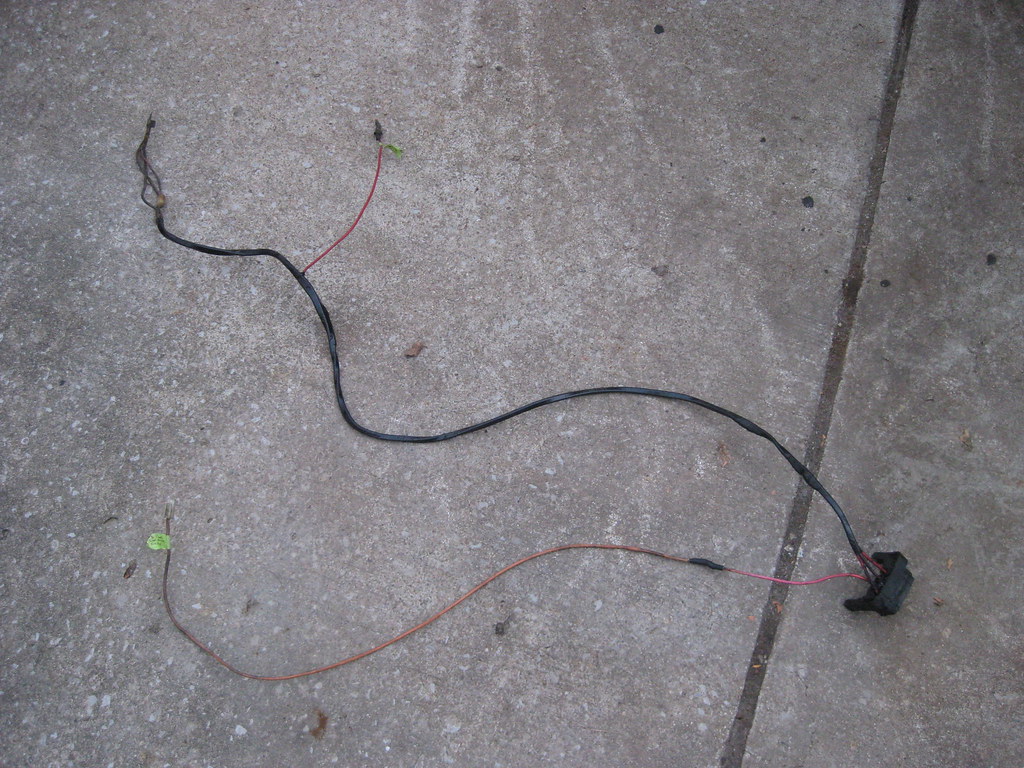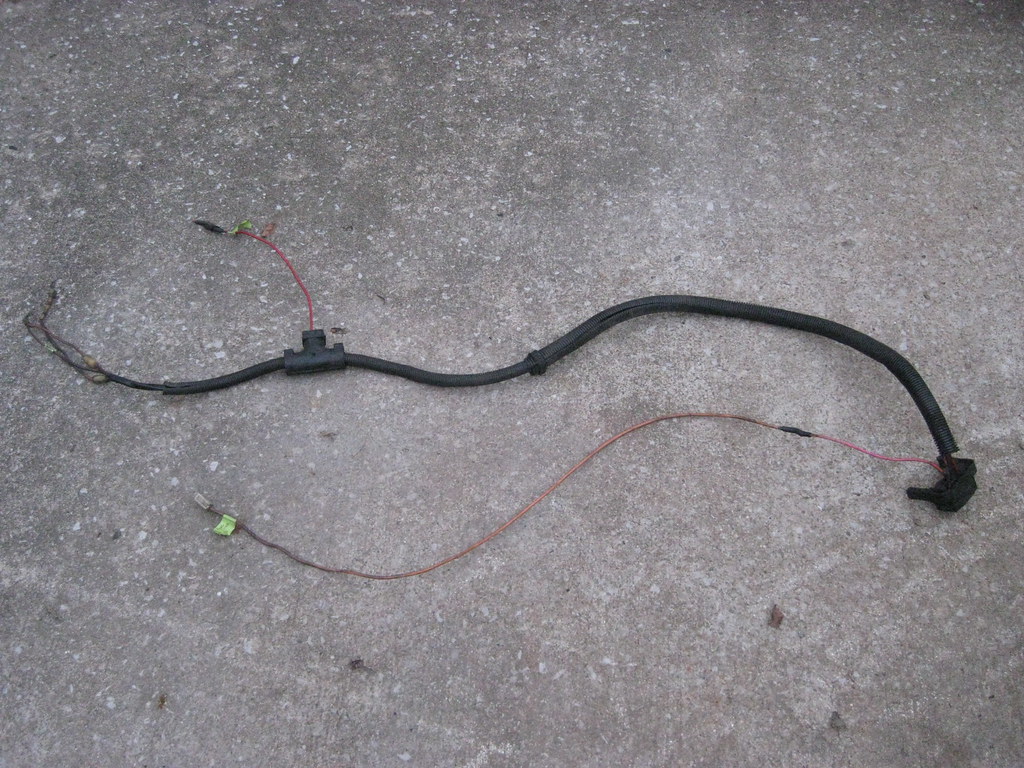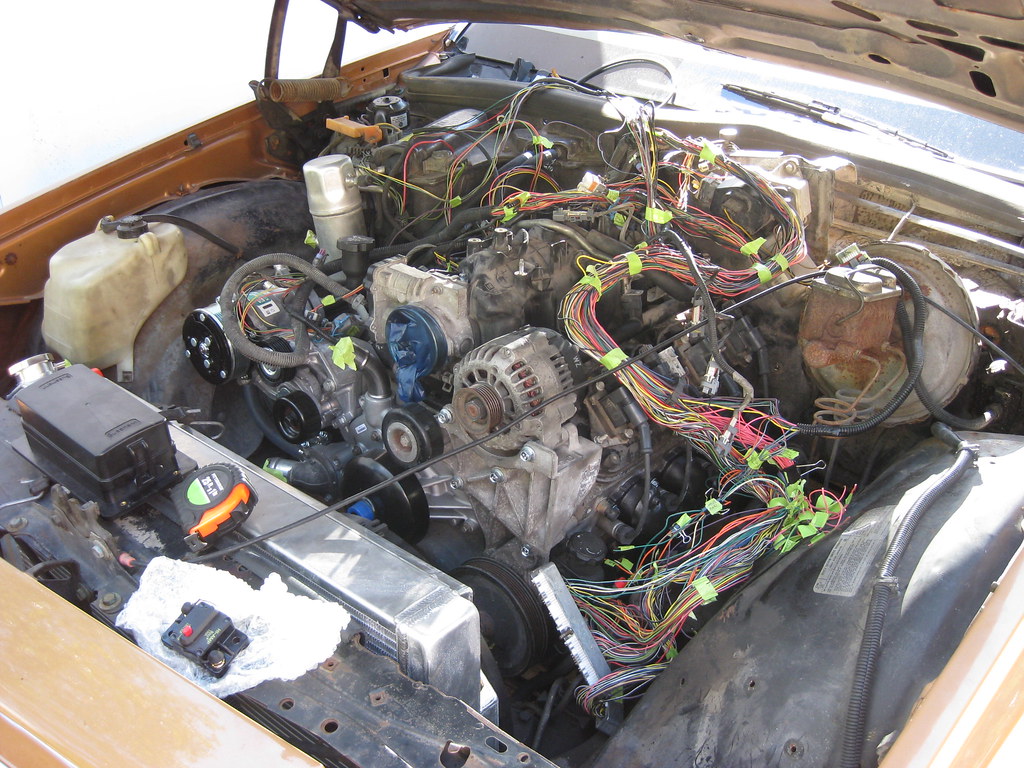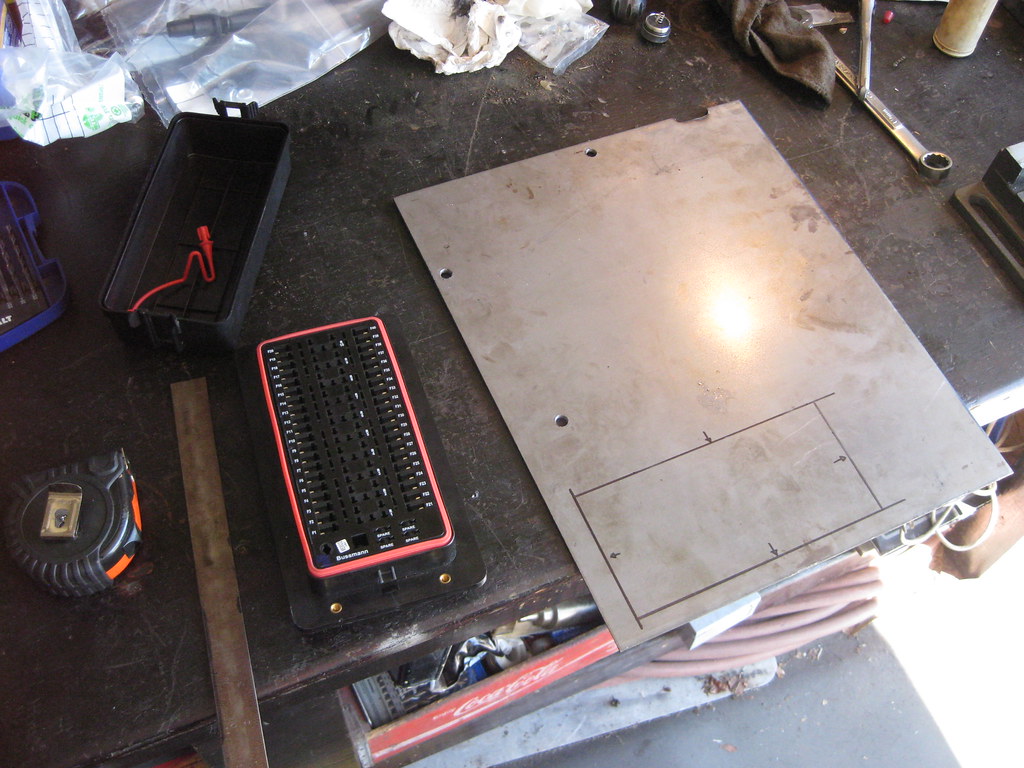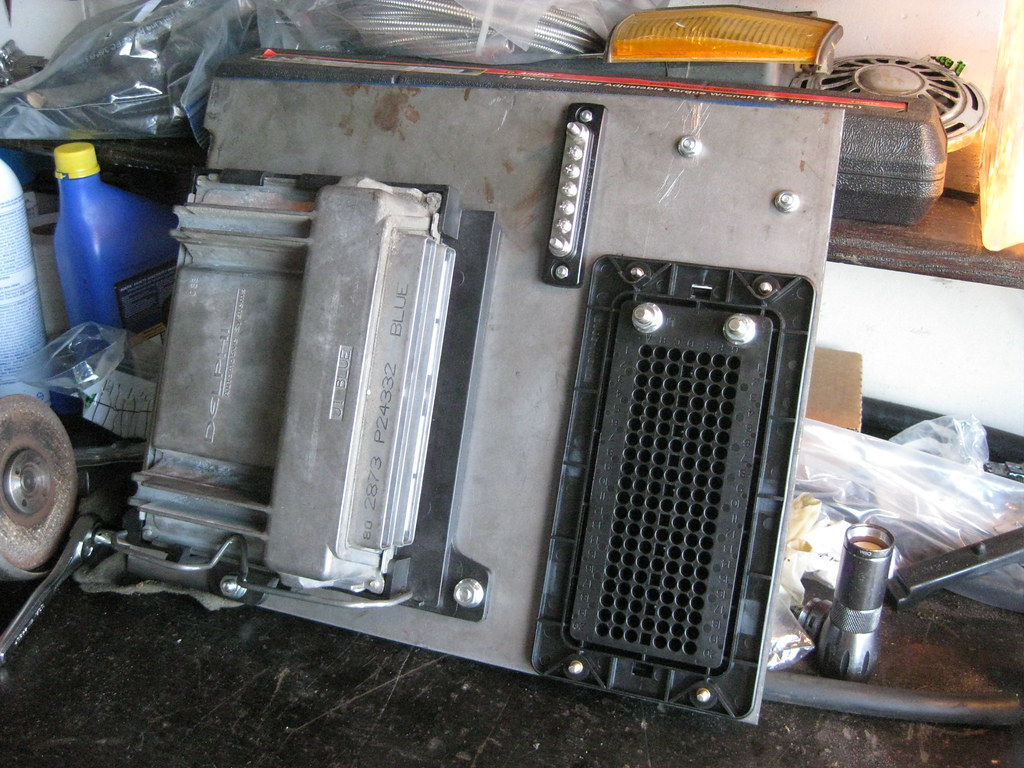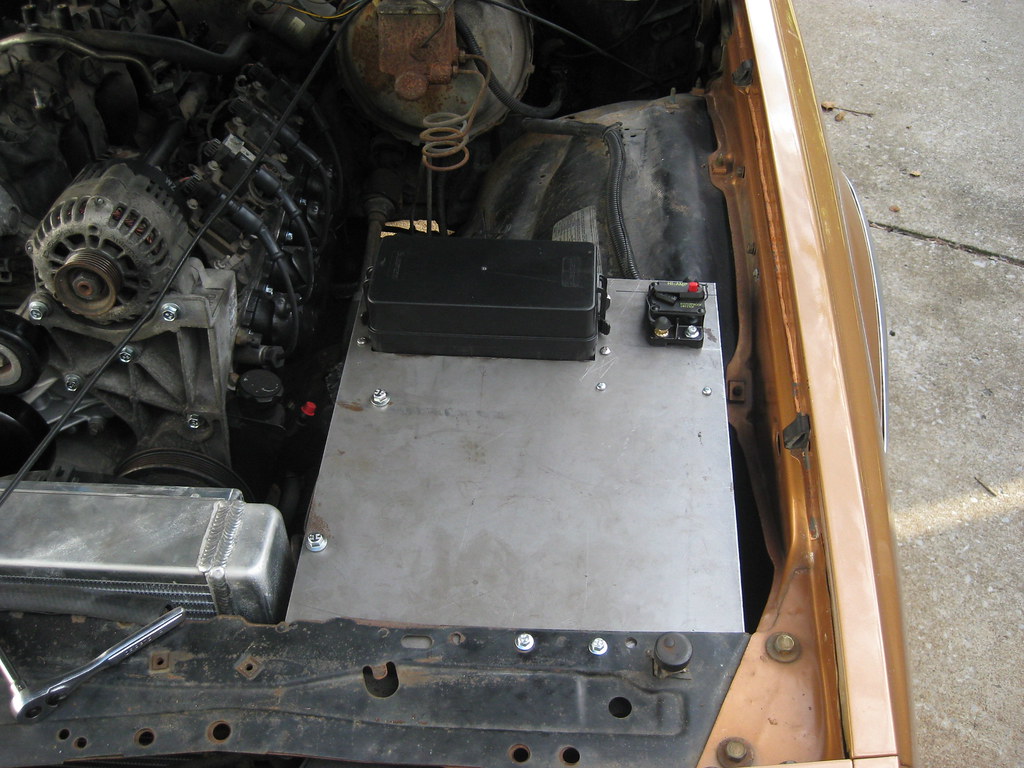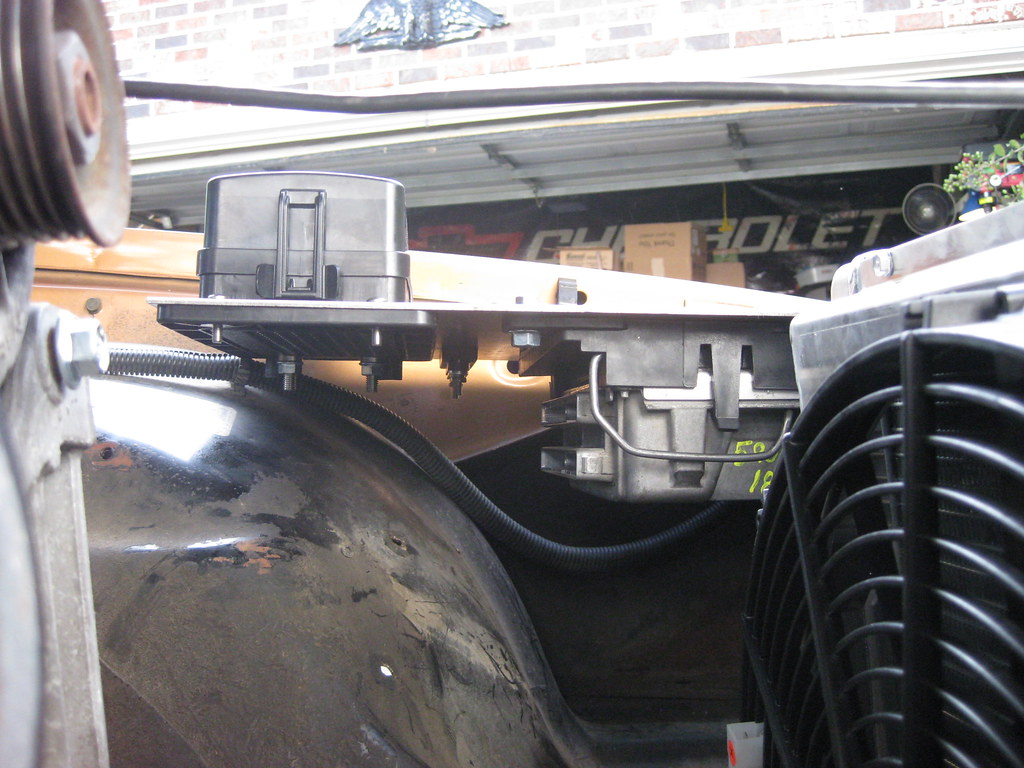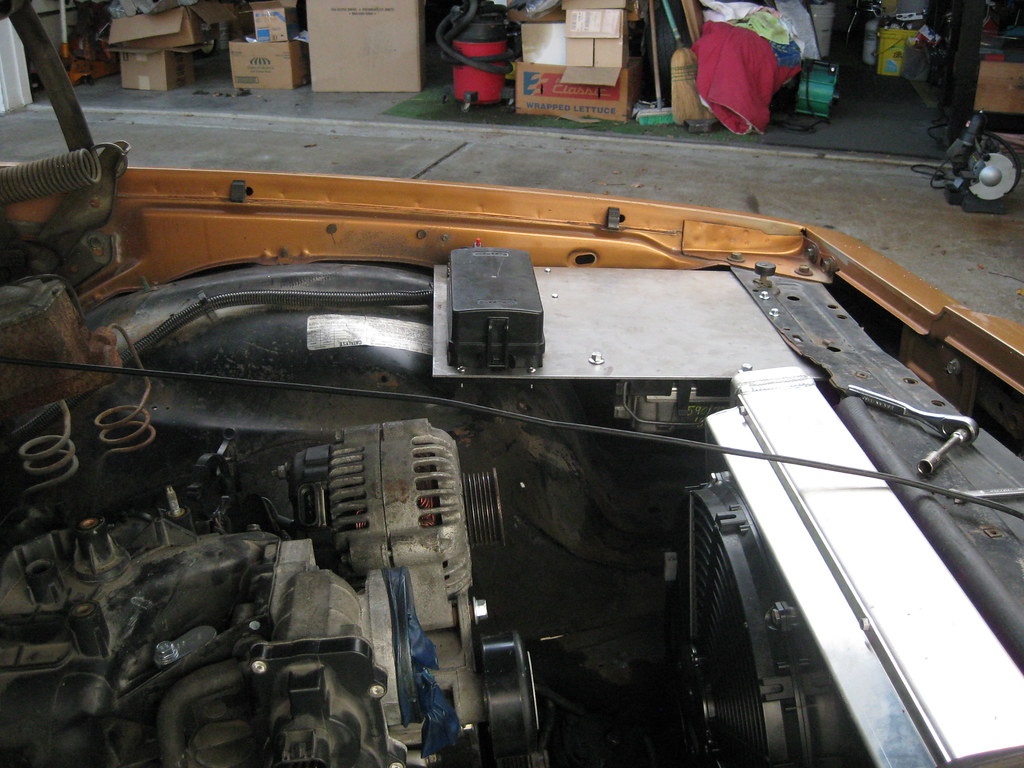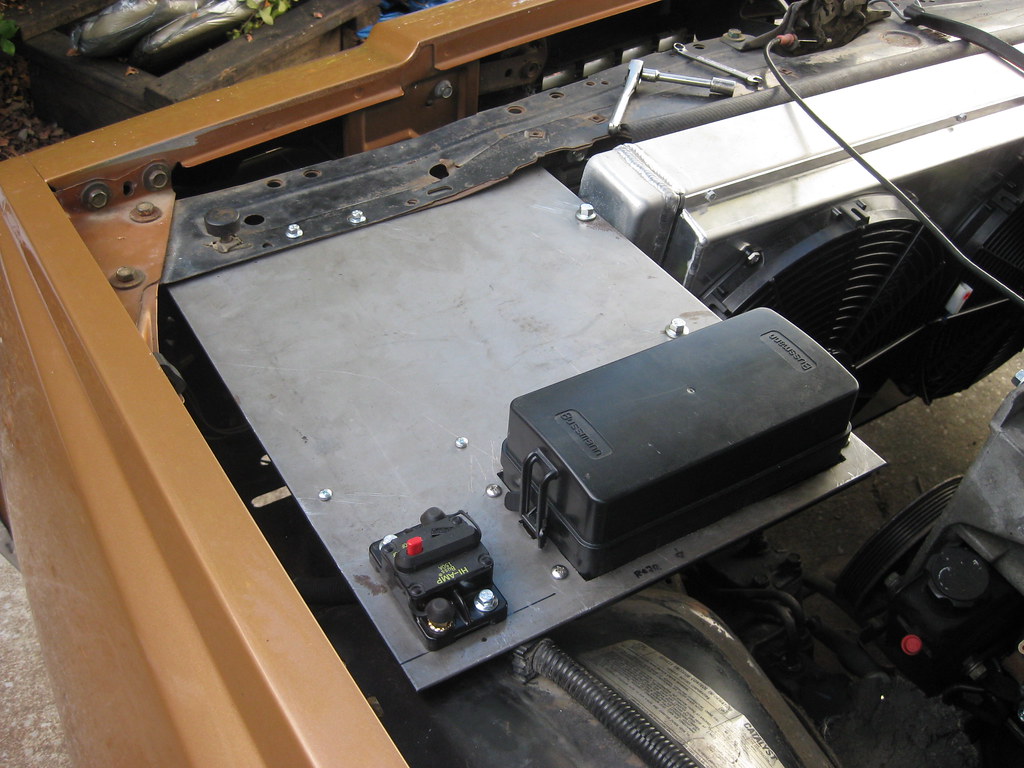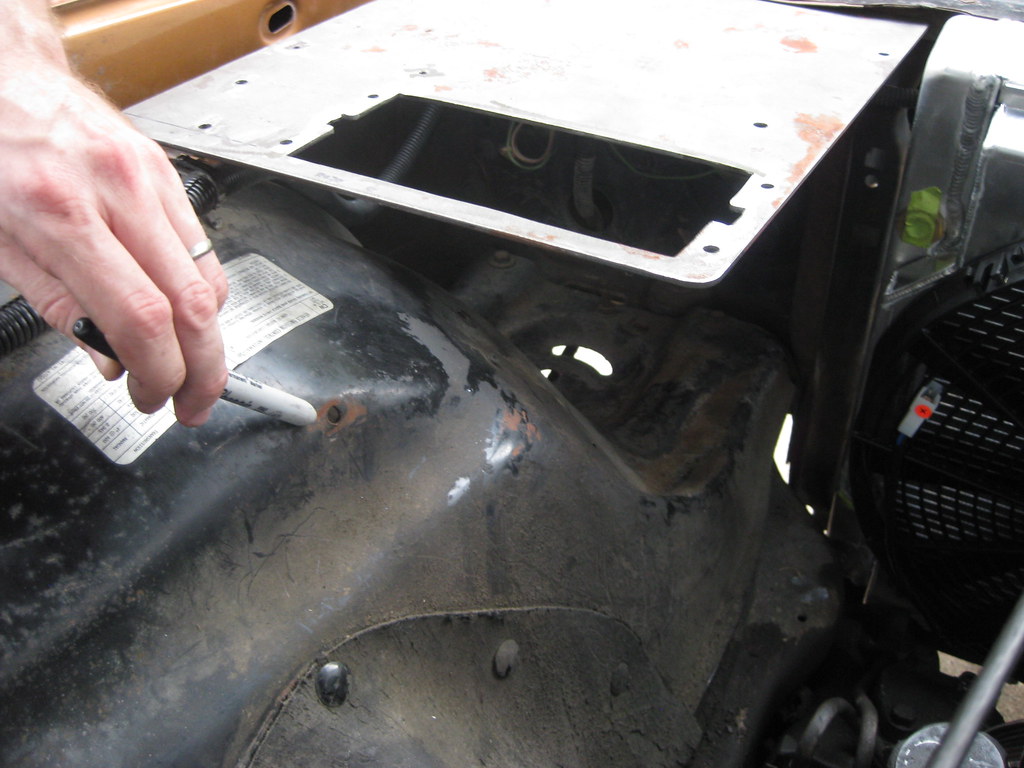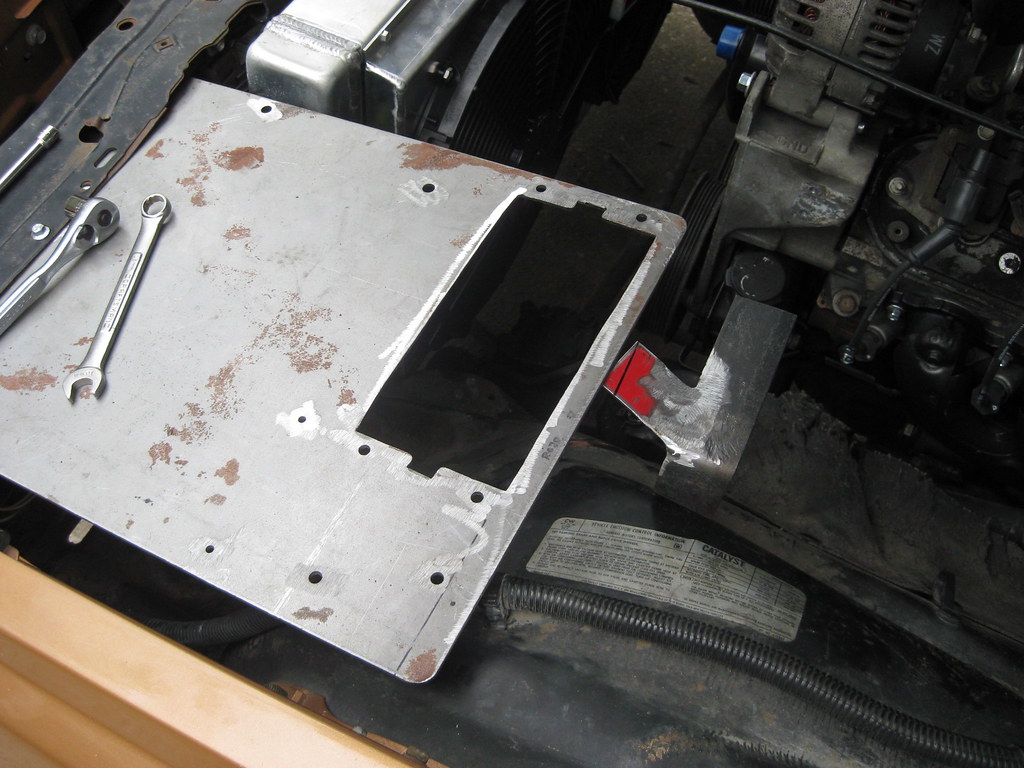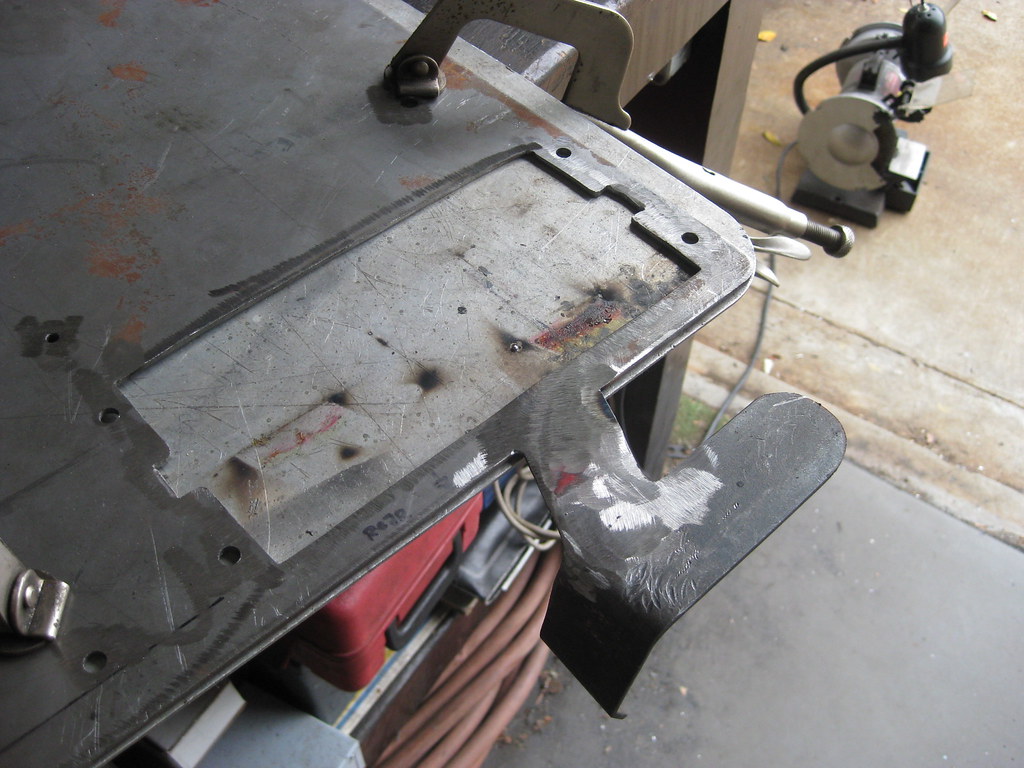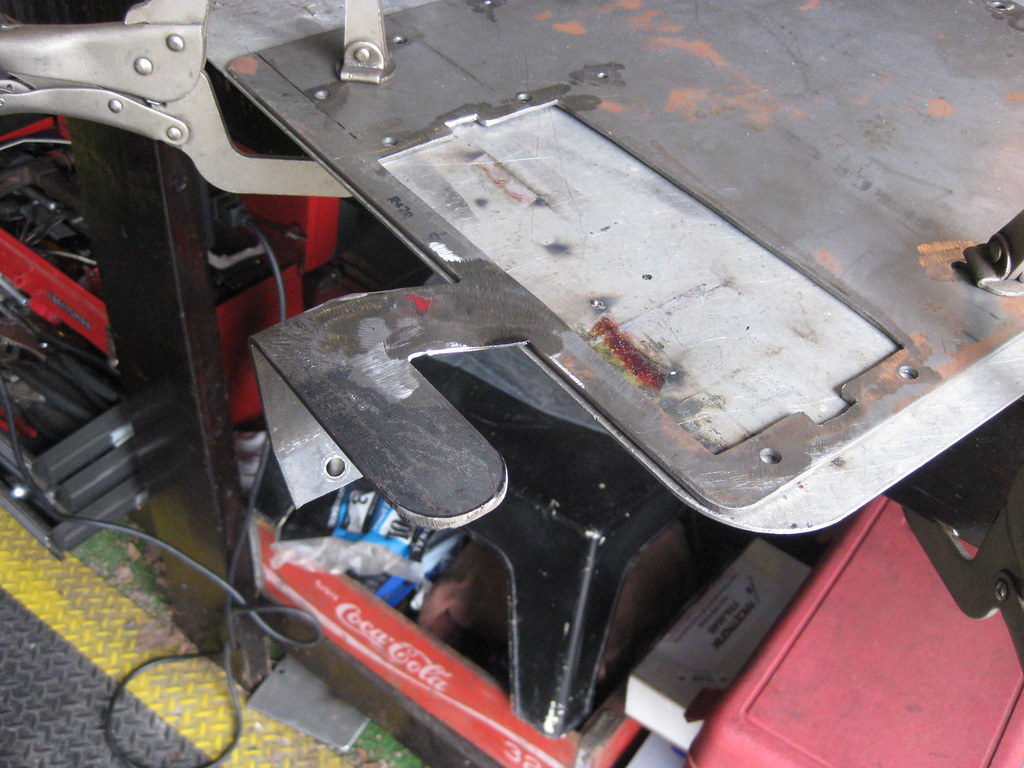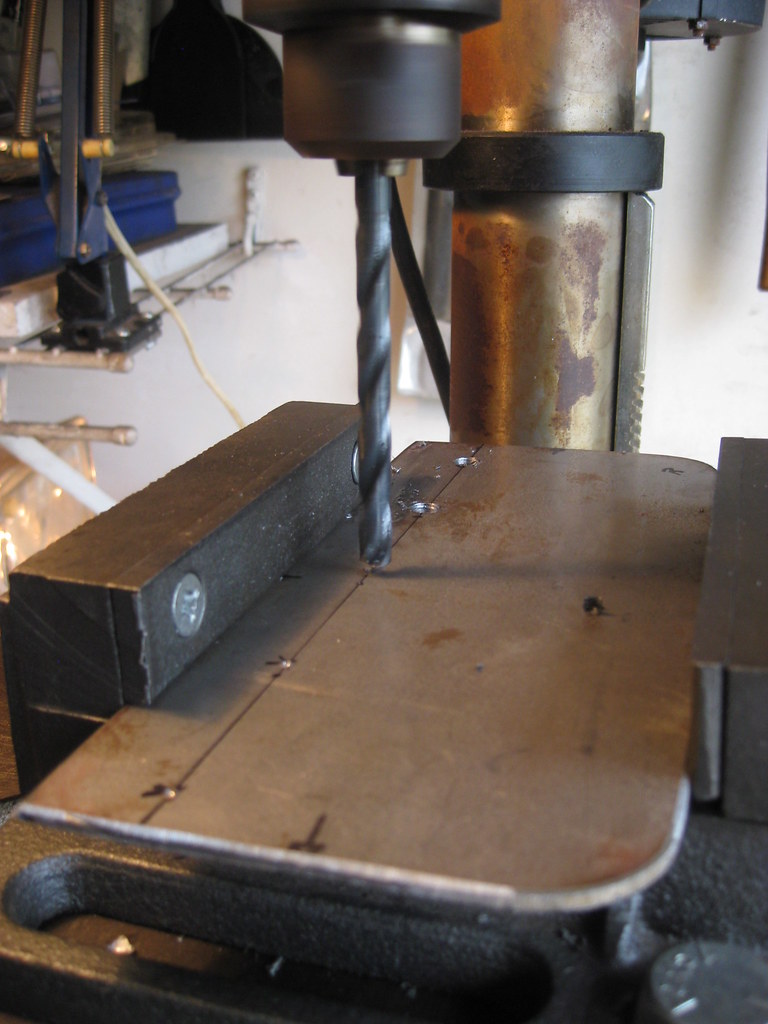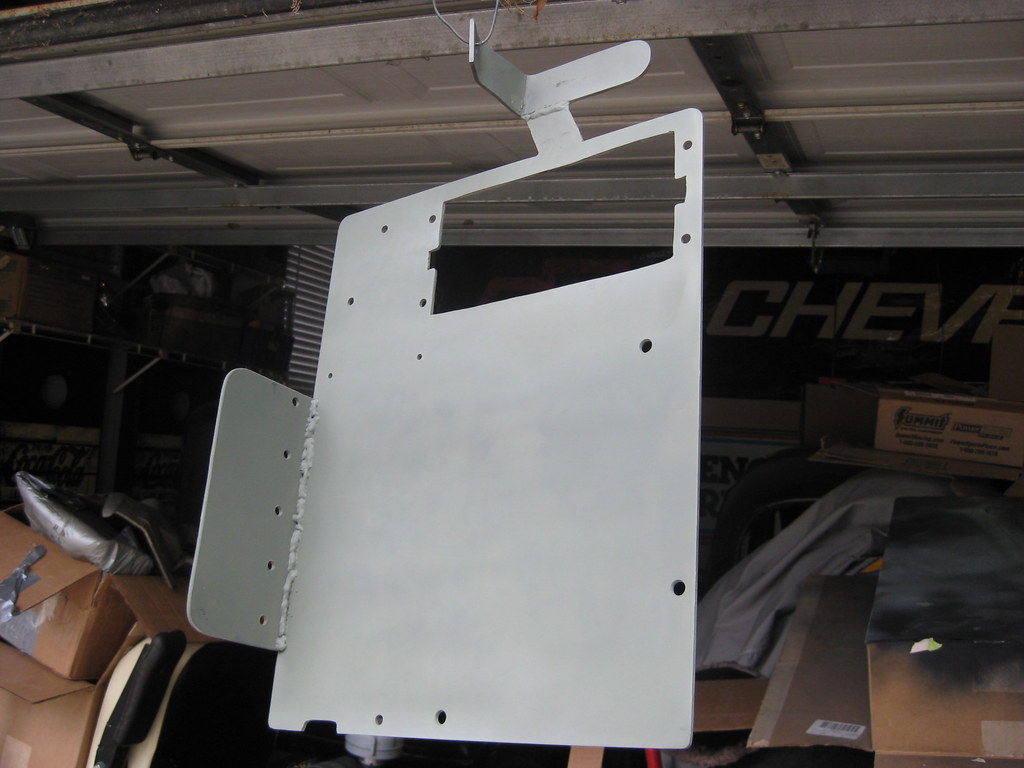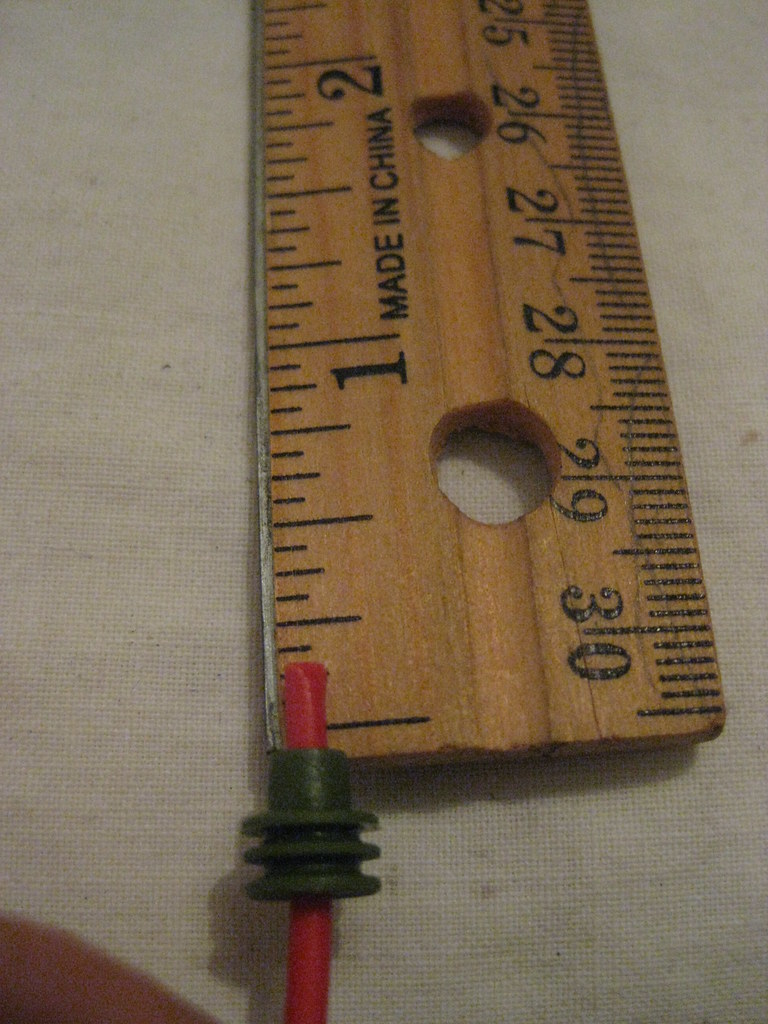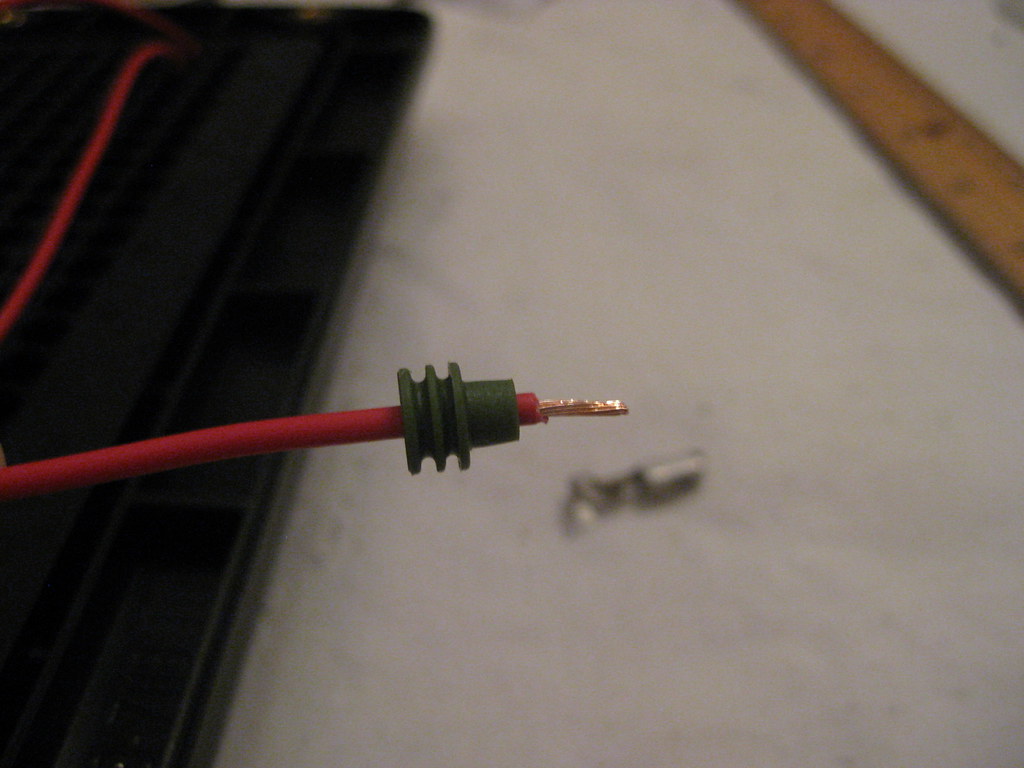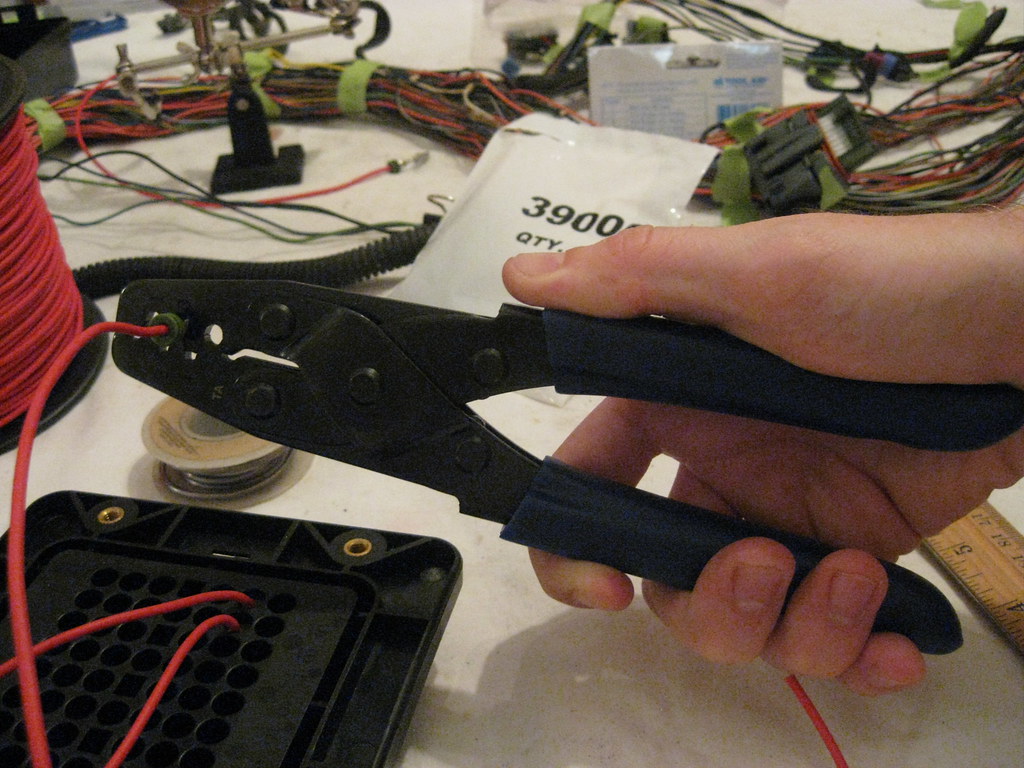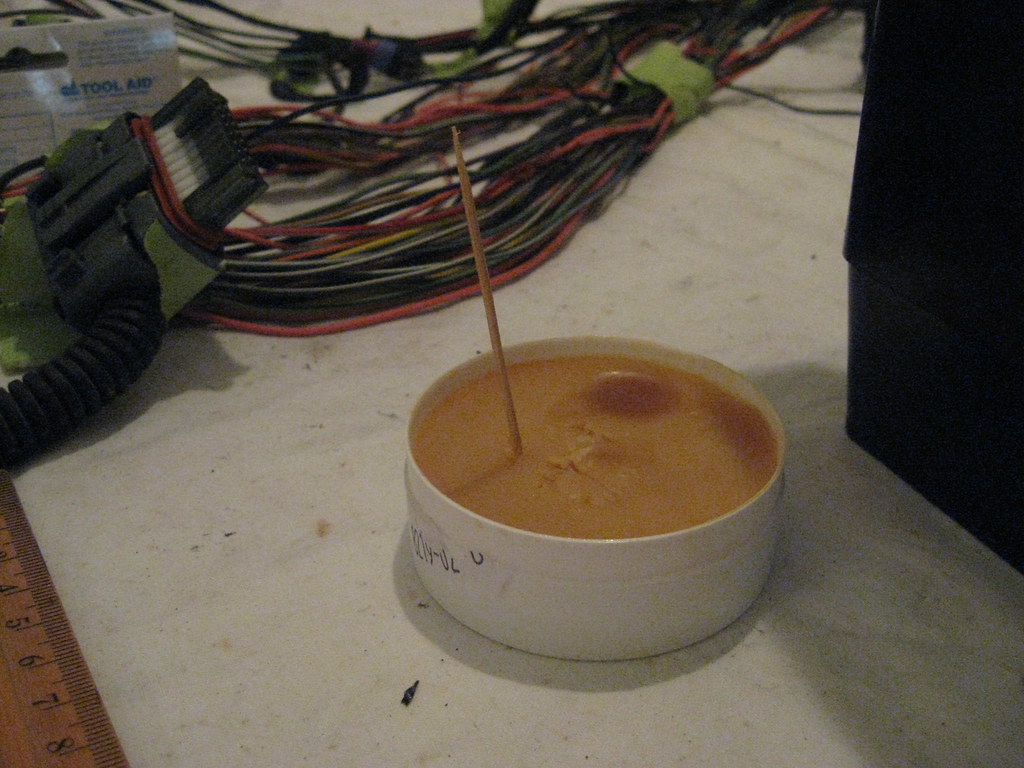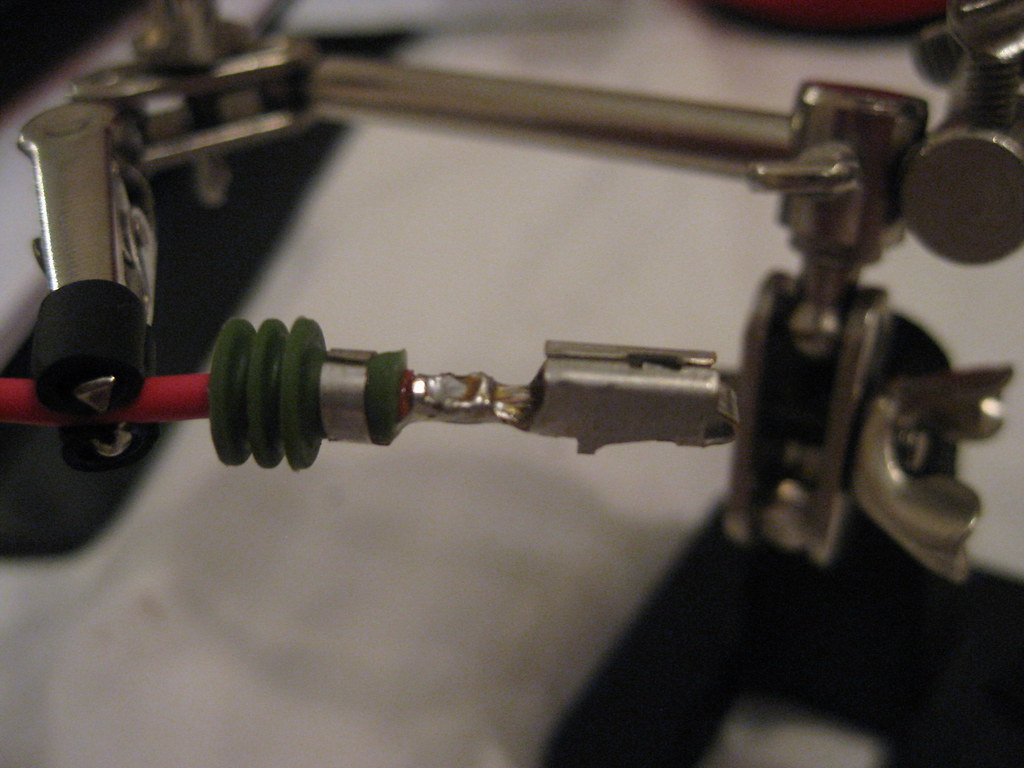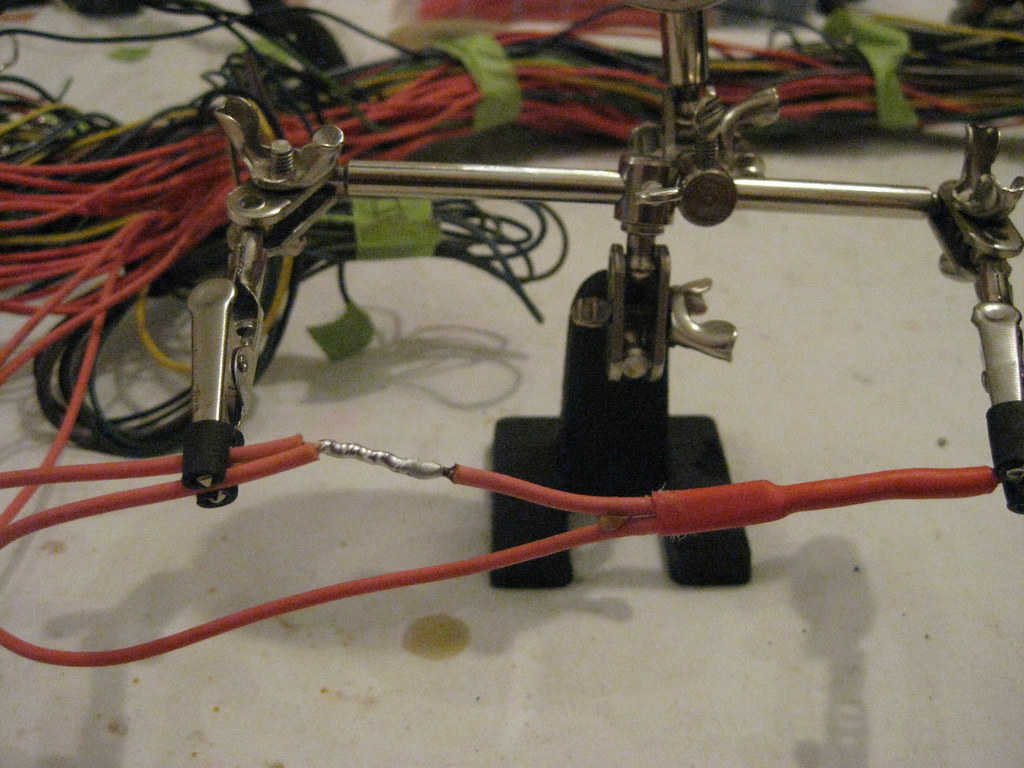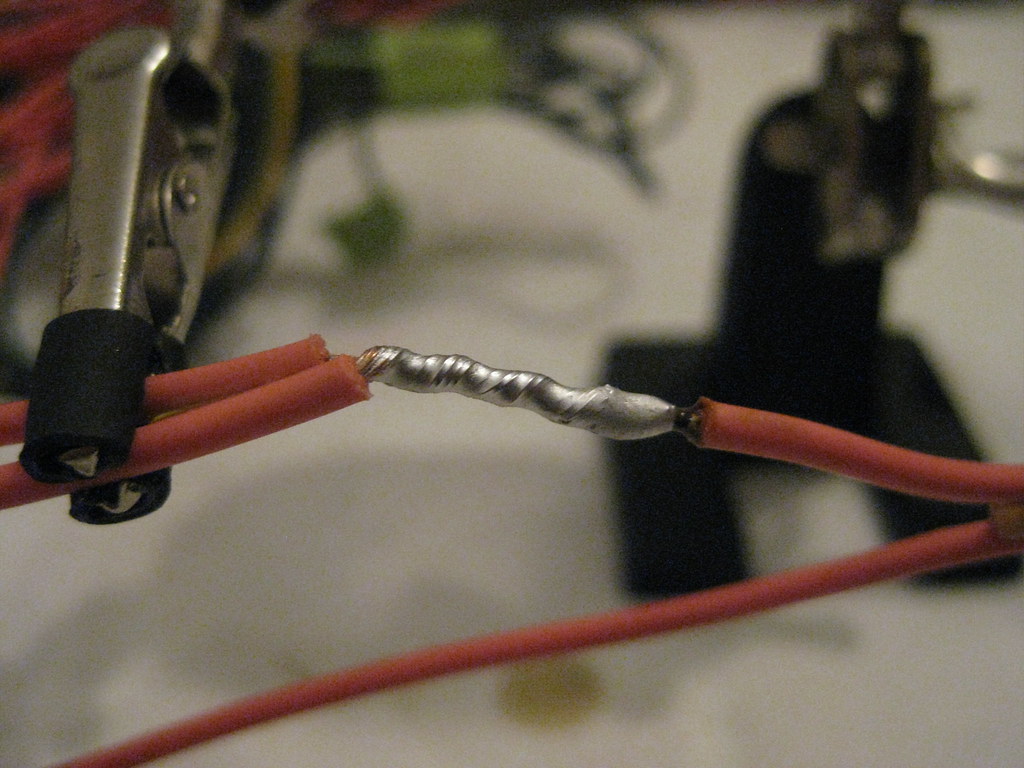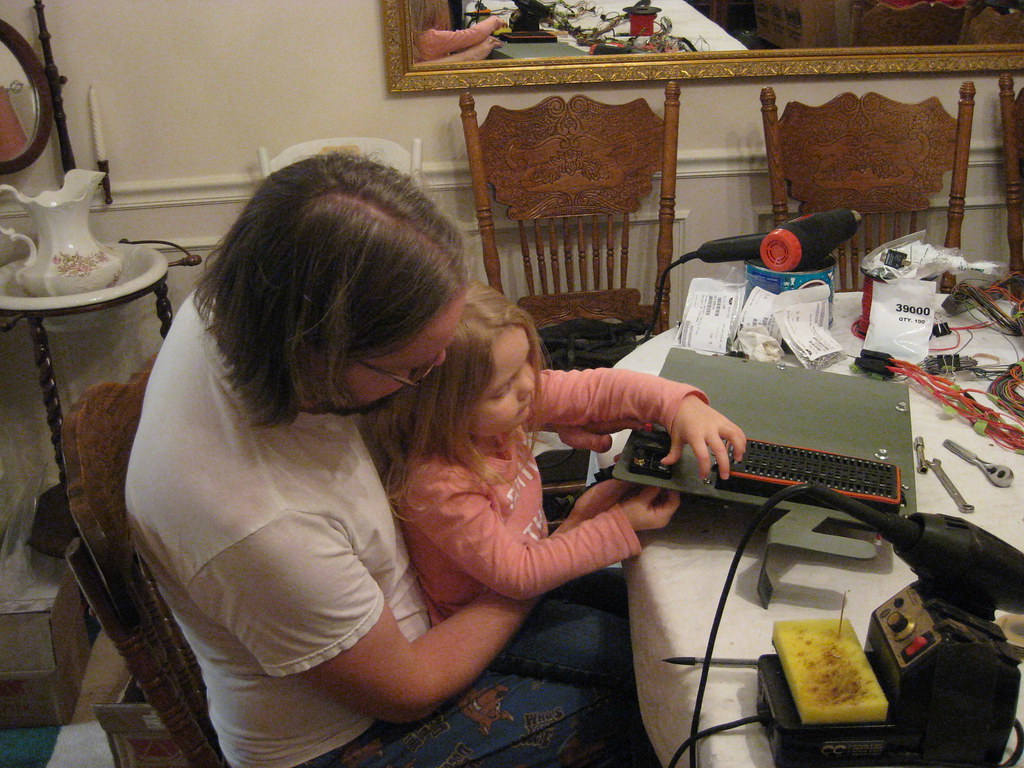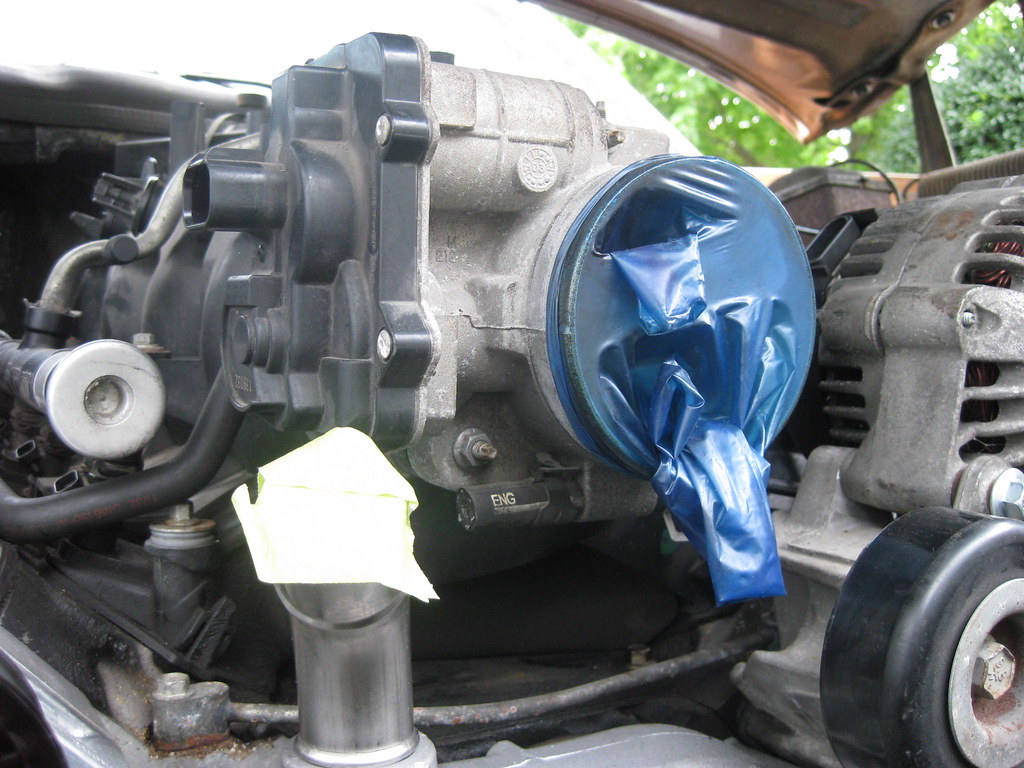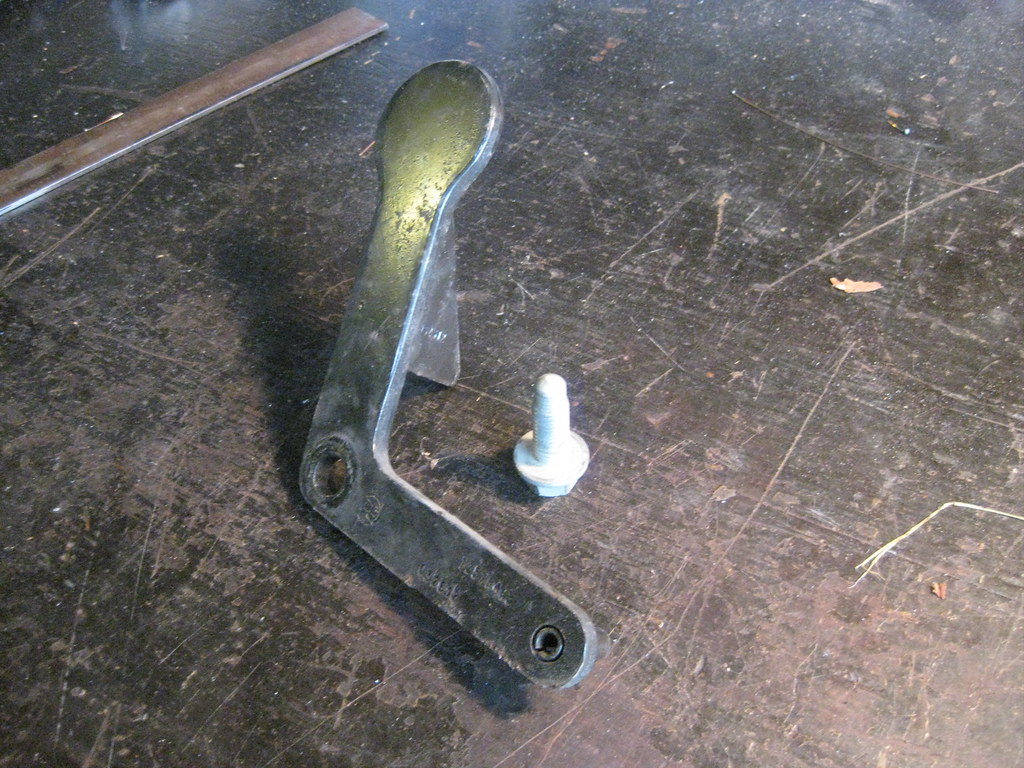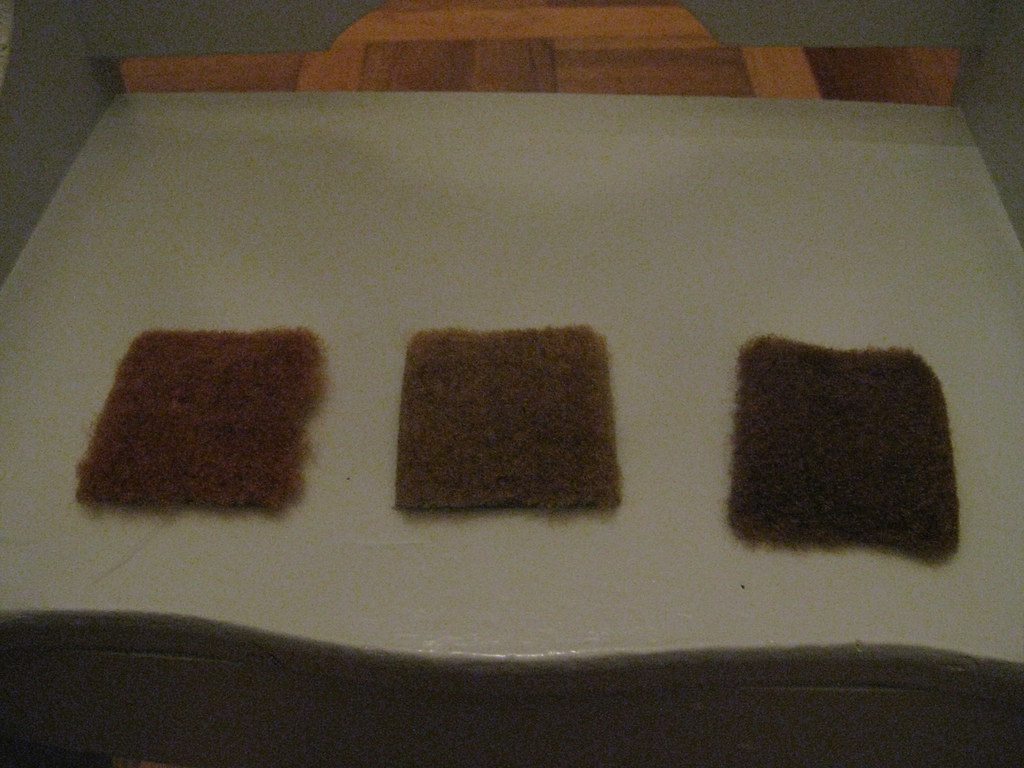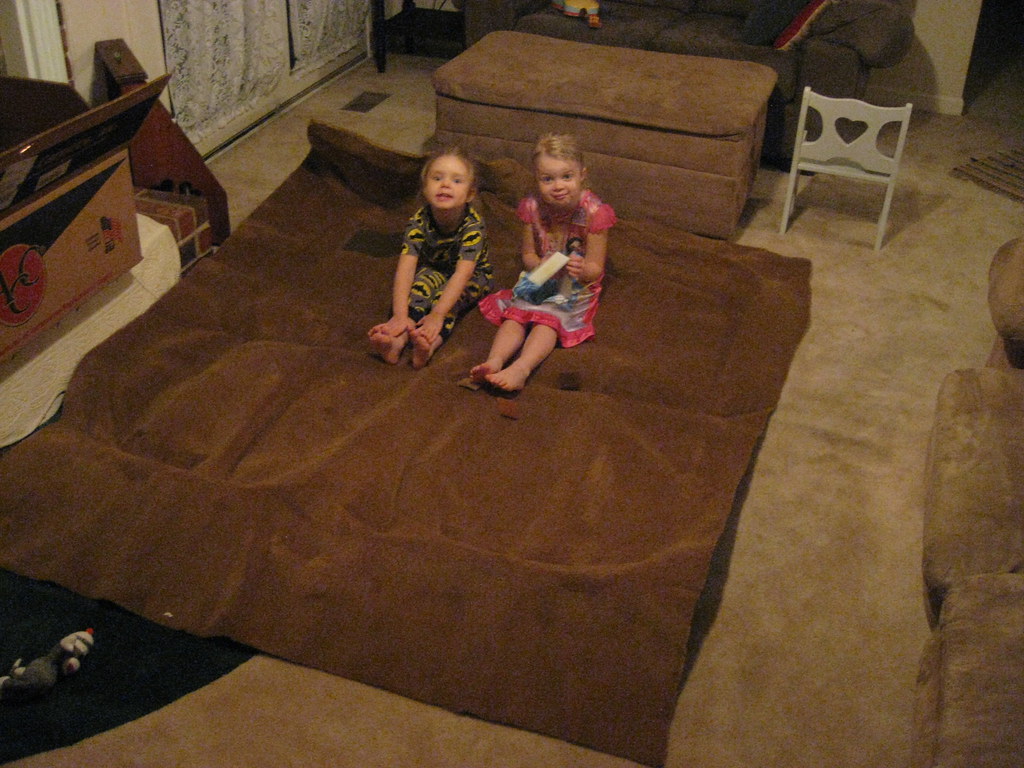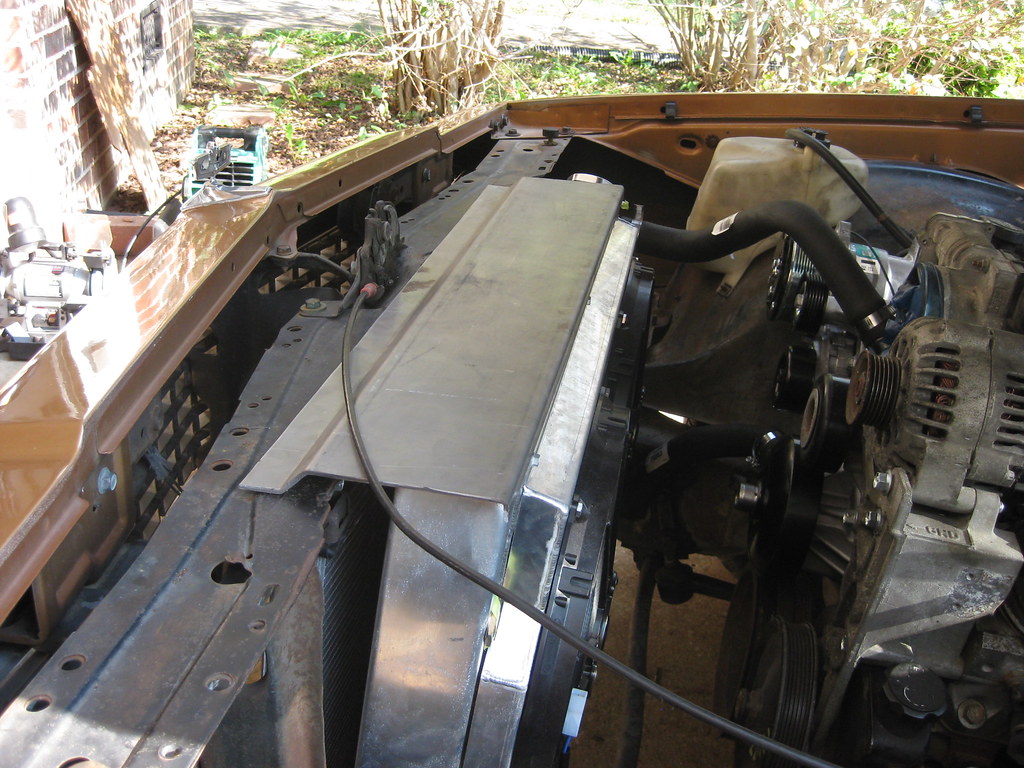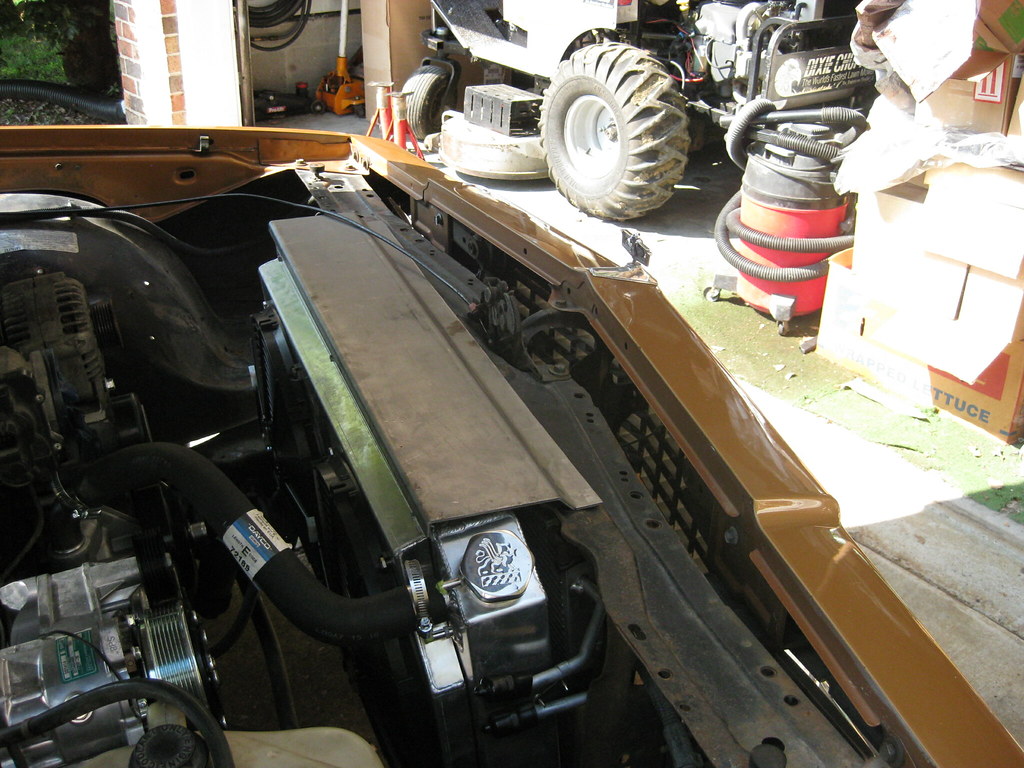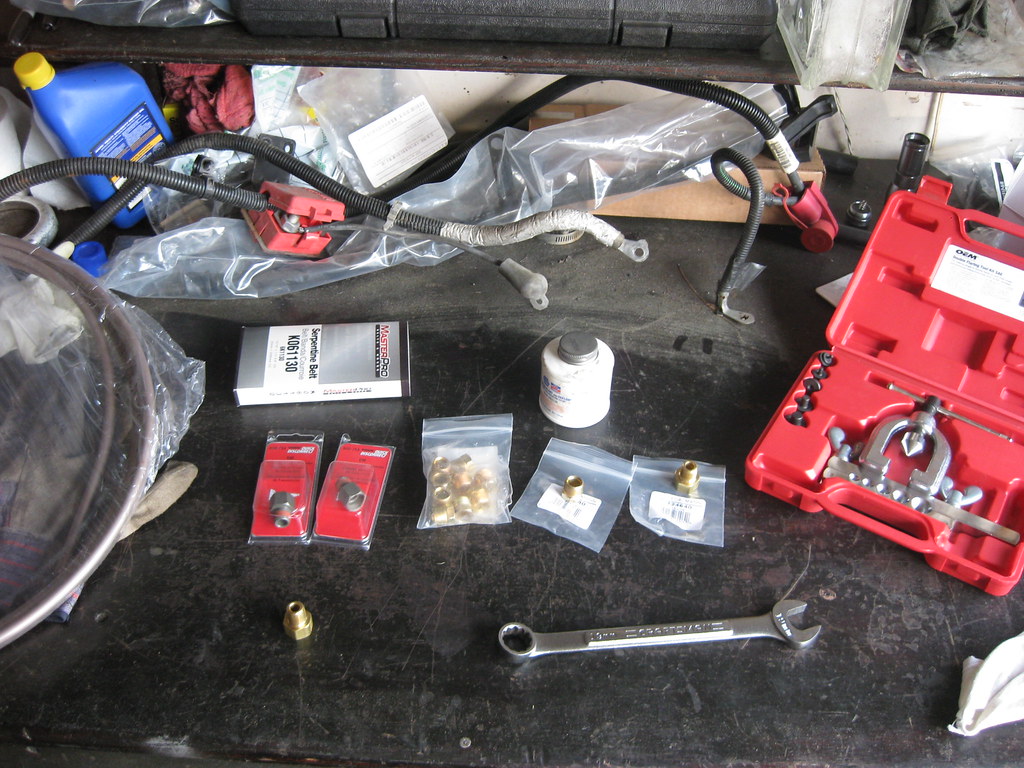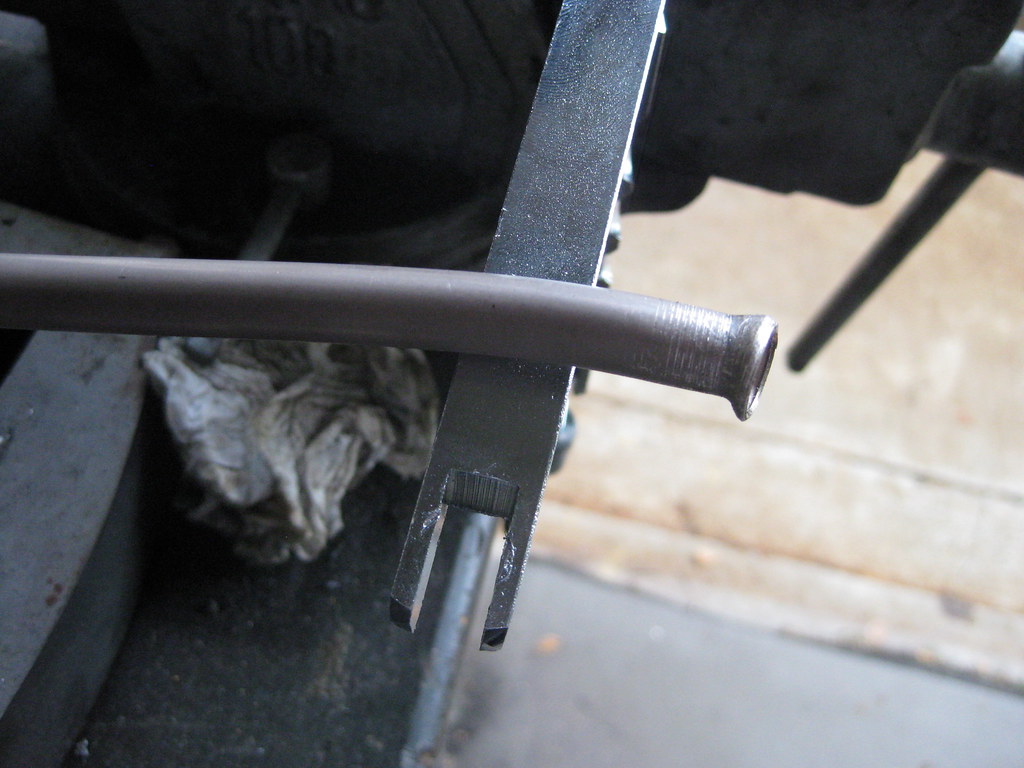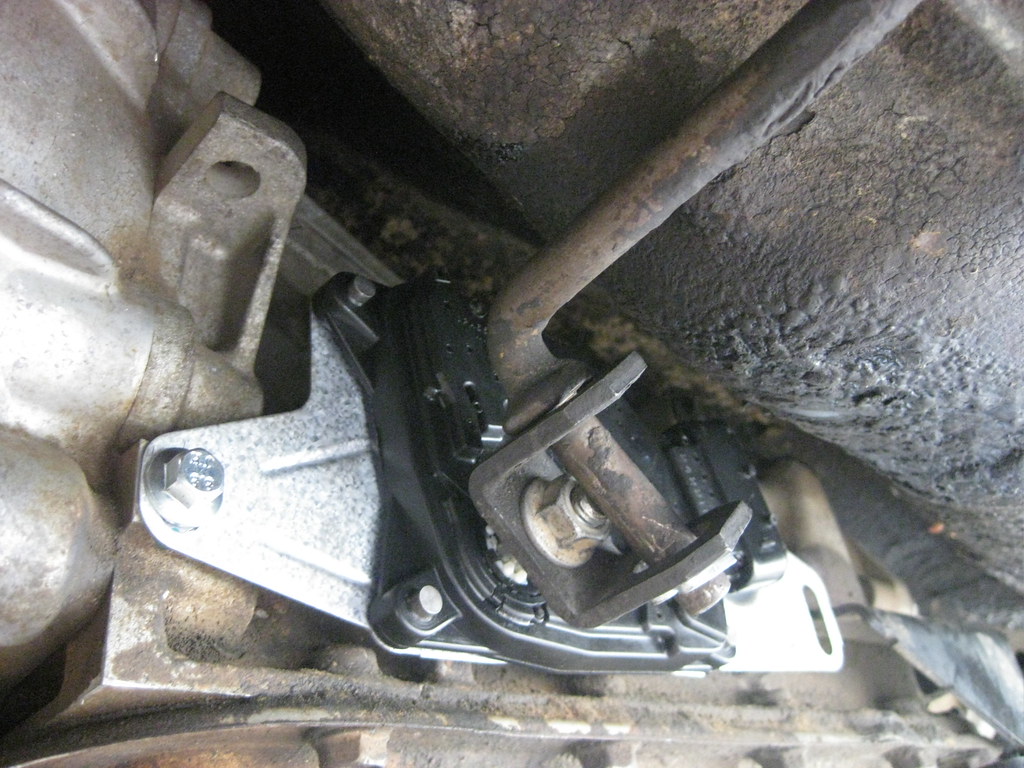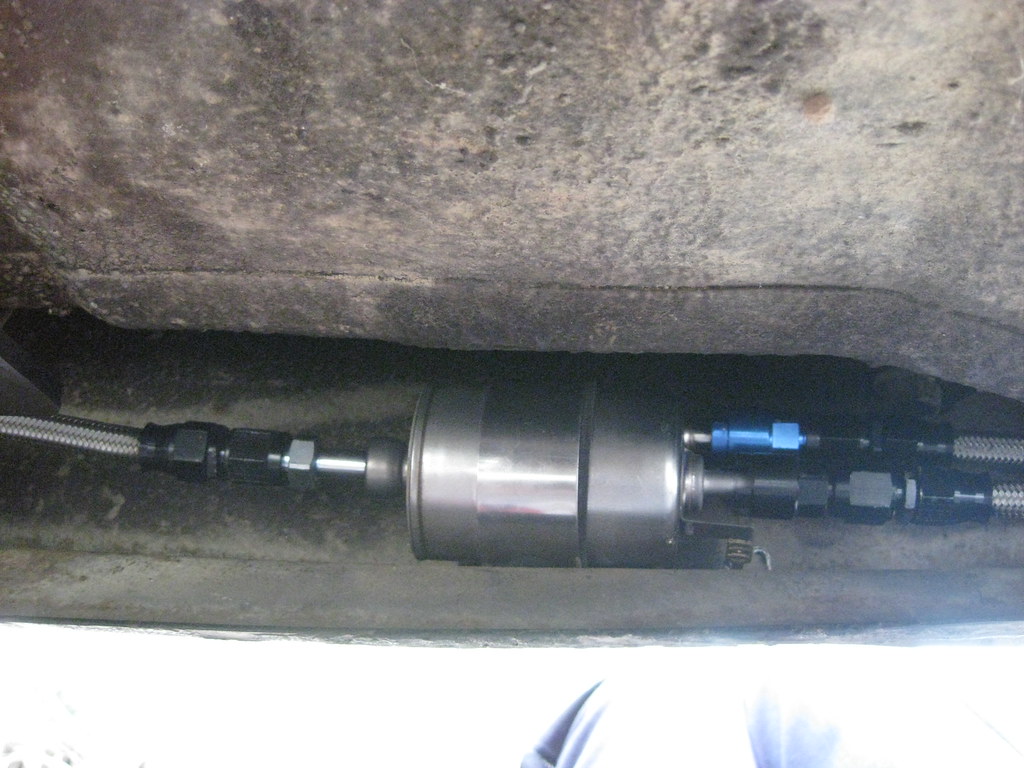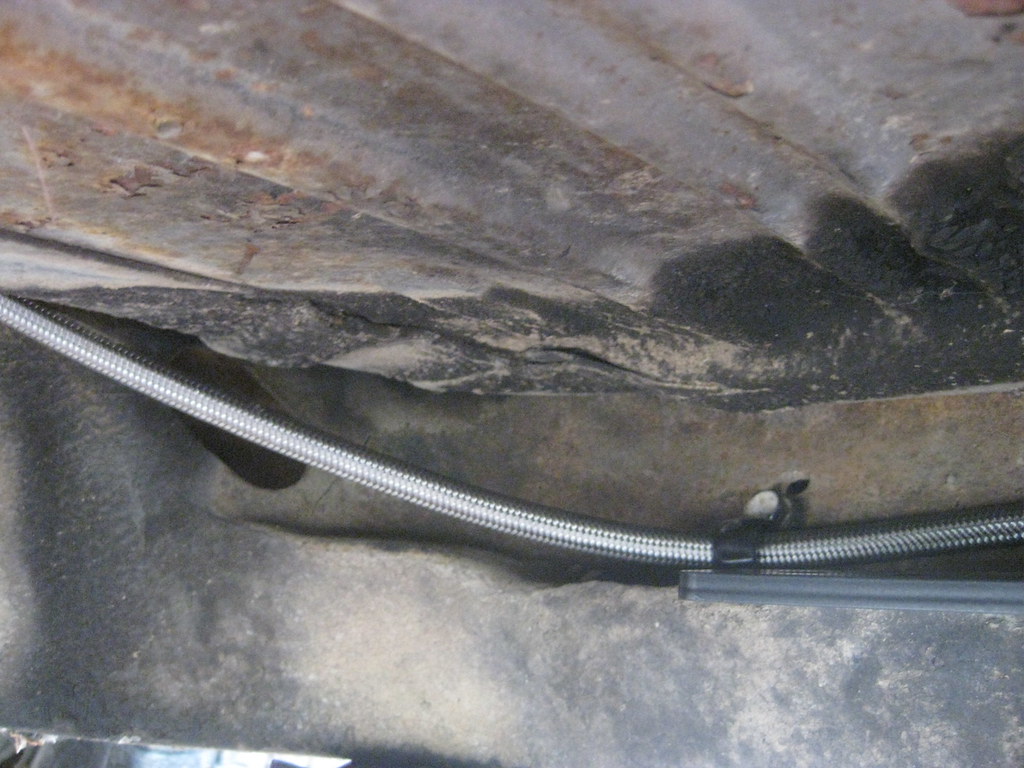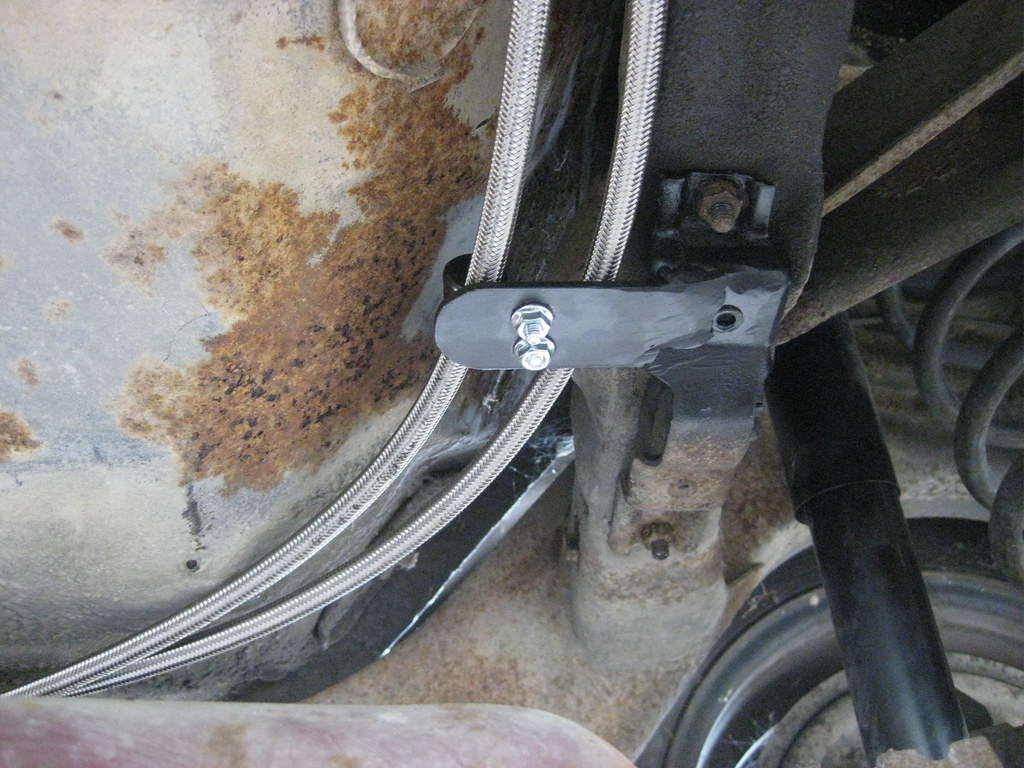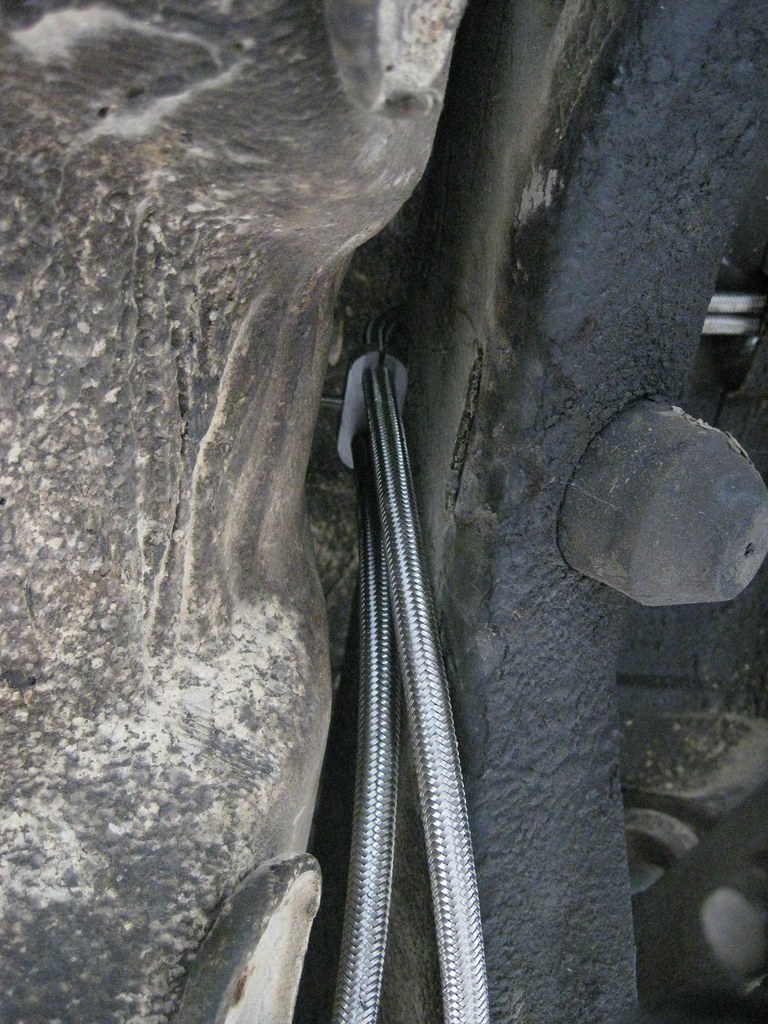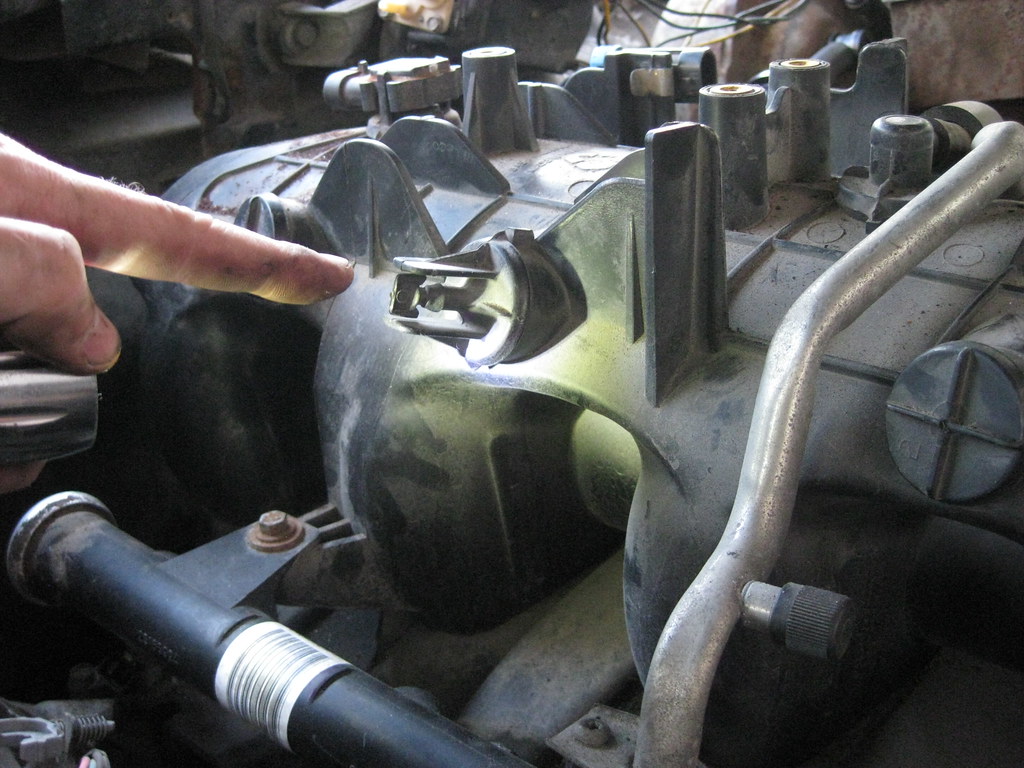I called the exhaust shop down the street last week and they said they would take the car even if it didn't run so Dad brought the truck and trailer over and helped me load it up. Fortunately he had gotten the winch working a while back.
The shop is at the top of a small hill, until you consider pushing a car up the hill, then it becomes a very long mountain. Fortunately I was able to back the trailer up to the lift and pull the ramps out right onto the lift. Pushing the car wasn't difficult at all, not that I was actually pushing; I was steering at that point.
Here's a shot of the new gas tank and the old glass pack exhaust. This same shop put these on about 20 years ago. It was a very big deal for me to be able to get dual exhaust on The Caprice back then. I had access to what most would consider some pretty cool cars of the day, but I wasn't interested in them and loved this Caprice. It used to be a loaner car for Dad's dealership and when I found it, it was on the back lot with weeds grown all around it and was soon to be on its way to the junkyard. I really loved the look of the car, but at the time almost no one at all appreciated these cars, and this certainly wasn't even a nice example of one. I used to get made fun of quite a lot for driving it. My parents thought my love of this car was some kind of teenage rebellion of sorts because I chose it over something nice, but I never actually went through any teenage rebellion phases and just really loved this particular car. As a result, Dad never let me modify or spend money on the car because he didn't like it and thought it was a waste of money, so when I finally convinced him to let me put dual exhaust with glass packs on it it was a big deal. Also at some point someone had traded in a Chevrolet S10 with 7 inch rallies on it and I convinced him to let me swap them onto my car and take the hubcaps and whitewalls off. Eventually I used that as a segue to getting some 8 inch Corvette rallies and white letter tires. Years later someone with a body shop owed Dad a favor so I actually was able to get the car painted. I'll miss the sound of the old glass packs. Sometimes I would come home on summer weekend nights and sit behind the car and listen to the true dual idle out the pipes for a little while. It wasn't fast at all but it had a nice sound to it.
I don't have any photos of the finished exhaust because I wasn't there when they finish it. Because of my work schedule I'm not in town when the shop is open. Dad went by on Monday and picked the car up and we unloaded that night at the house.
The aftermarket transmission dipstick wasn't made exactly correct (no surprise) and the mounts wouldn't fit, so I had to make my own. I started by bolting a piece of cardboard to the block to use as a template.
Anything over a single bend is difficult to impossible with my small vice. I used some of the leftover 1/8" steel from the upper radiator mount, which I intentionally ordered large because I figured a need would arise for the excess. This setup doesn't make good looking bends, but they're passable for this project.
I had to mark where to drill the second hold for the dipstick tube, which was very difficult because there was a lot of play in the tube so I had to mark its entire travel and also getting the marker between the firewall and tube was a task in and of itself. I located where the hole needed to be with a punch.
And then I had to transfer that mark to the other side of the mount so I could put the piece in the drill press.
I eventually got all of the bends and holes where they needed to be.
Primered, painted, and ready to install. It still surprises me how long it takes to make things like this. I think I ended up having about 4 hours just in this mount, mostly because of the difficulty of measuring the bends and holes in such a compact and difficult to reach space.
I had to cut down a couple bolts to make everything work, but the hard part was getting everything tightened down. I think I had to crawl under and pick up the bolt or my wrench no less than 8 times.
I also had to make a mount for the transmission lines. I ordered some line clamps. That body clip I had welded and painted for the fender and then found out I didn't need ended up being the perfect solution to for this mount.
I mocked everything into place several times and drilled the holes for the line clamps and shortened the bolt. I had bought a couple of these flanged bolts for something else but ended up not needing them.
I was in a hurry last Saturday morning when I made this transmission line because I had to get the car to the exhaust shop before 12 and I needed the line to be in place so the shop would know where to run the exhaust pipes.
I ended up kinking the line so I knew I would have to replace it.
I knew immediately when it happened I had ruined the line. I was pulling gently and all at once it gave away and bent. I'm also not very good at this, so that doesn't help either. This copper aluminum line is very nice to work with, but kinks very easily.
There was also a smaller kink on the same line closer to the radiator so I replaced the entire line from here forward.
I made sure to put fittings on the lines immediately so I wouldn't forget.
The rear section of the line would not come out without taking a lot of the bends out and reshaping it to reinstall. Fitting the flaring tool was very tight, but it was possible. It would not have worked with the traditional flaring tools I had been using. I can't say enough about how great this tool has been. I don't even worry about how the flare is going to turn out because it has yet to make anything other than a perfectly round flare.
I used the old line as a template and April helped me hold the excess roll of line while I bent it into shape. Because of the tight fit of the lower line near the radiator there is practically zero room for error in the shape.
I had anticipated this earlier in the week and ordered some female flared fittings.
The finished mount ended up like this. The 1/8" steel provided a very study mount.
And here are the lines after the final installation. I would really like to have tucked them in closer and put some tighter bends in them but this is the best I could do with the tools and skill that I have. I was running out of line and didn't have enough to experiment with. I'm curious if the air intake tube will have enough room to fit behind these.
Finally, a kink-free turn. I would like to have been able to get the lines to look more symmetrical but I think it would take more than what I have available to make them look factory perfect.
I ordered the line clamps in a two pack. I installed the other here which now has given the lines more stability and they do not make contact with anything around them even under vibration.
Saturday, October 27, 2018
Sunday, October 14, 2018
Radiator Life Support
I've gotten to the point where I've had to add a few wires to the harness connector. I kept all of wires I removed from the harness because many of them had the connection on them that fits into the PCM, so I was able to repurpose those wires for things like the air conditioner and electric fans.
After weeks upon weeks of working in heat that was too hot I was unfortunately not surprised to find it was actually cold this weekend. I had to wear a jacket and a hat when just last weekend it was in the high 90s. It seems like the last few years we have skipped fall.
When I have spare moments I tend to sit and think about what I have left on the build. I began thinking about how the lower mounts on the radiator cause it to lean back toward the engine. It leans with enough force that it was putting some amount of strain on the upper radiator mounts when I was test fitting them. Ideally, there should be no fore or aft tension on the radiator mount. I tried to think of a way to remedy this without modifying the lower mounts but I ultimately decided I would have to remove the mounts and reweld the mounting tabs to set the radiator back. I really, really did not want to have to dig back into that project again, but I knew I had to to make it right. There was a chance the vibration from the road (or the temptation to show the girls how dad used to jump the railroad tracks) could cause the radiator to come loose from the upper mount. When I pulled the radiator out I found that the mounts were actually sitting flat against the lower radiator support. The solution was to take vise grips and to bend the entire lower support, which not only worked perfectly, but also was a much, much easier and time saving solution.
The end result is that the radiator now sits in a neutral location right against the rubber I put against the core support. This will put a lot less stress on the mounts because to pull the radiator back to where it needed to be previously took quite a bit of force.
Remembering back, I had previously had the metal shop bend the metal for the upper radiator mount but the rise was not at the correct angle. I cut off the extra length of the upper radiator mount and made a template with a hammer and vise to get it close to the shape I needed the larger piece to be. I took both pieces back to the metal shop and they rebent it to match the template.
The shape of the rubber isolaters was not allowing as tight of a grip on the radiator as I would prefer so I drew out some lines and gave the corners more of a right angle.
I can't remember what estate or yard sale I picked up this electric dremel, but it is about 100% better than the old pneumatic one I had.
I trimmed the front and back of the isolators and the fitment and grip afterward was much better.
Then I had to drill the holes for the isolator mounts. These had to be in the exact right location so that the turn down on the back of the mount would hold the isolator in place and the hole would hold the nipple in place as well.
Fortunately they turned out good and I was glad because I was not looking forward to welding those holes up and starting over.
Measure 200 times and cut once with a grimace, then ask someone else to look because you don't have the nerve.
Then I trimmed a section out of the rubber on the core support for better fitment and support.
Next I had to drill the holes that would hold the radiator mount in place. The problem here was that the holes in the core support were all boxed in and I couldn't reach underneath to mark where the holes were onto a piece of cardboard. I taped a piece of paper on the area and punched the holes into the paper.
Then I transferred the holes in the paper into a piece of cardboard.
Then I test fit the cardboard to make sure they were correct. One bolt was missing and two others didn't want to thread very good so I had to run to the hardware store and got four new boolts.
Then I transferred the cardboard onto the mount. I had to locate the far left and right hole and the middle two would fall in line. I also made a cutout for the hood spring, which on this car is attached to the hood rather than the core support. At long last, it was finished, and it fit and it hold the radiator very secure.
I couldn't have imagined how difficult, start to finish, this simple piece would have been. Aside from making the template, finding the steel and then finding a way to get it bent and then getting it bent to the right shape. Adding the time I've spent looking through scrapyards and trash dumpsters behind body shops to the trip into the city to buy the steel and then looking at different metal brakes, researching how to modify and upgrade them to bend 1/8" steel and ditching this idea and then calling no less than 10 people or companies trying to find a way to get it bent I can't even count the hours I have in this piece and early trips before work in the morning to the metal shop. If I had it to do over, now that I have it all figured out, it wouldn't take 1/10 of that time.
It would have been easier to run two arms over the top and mounted the radiator that way, but I like the look of these type mounts much better. Also, many of the other mounts I have seen are hard-mounted straight from the core support into the radiator with no rubber isolators. That may work fine on weekend toys but on a car I've had for 21 years and plan to continue to daily drive for several hundred thousand miles on I feel this was a better long term solution. I really wanted to laser cut a Caprice emblem on the top with etched colored glass under the holes and then put two colored LEDs under the mount that would have come on when the hood was raised but in my effort to again not go overboard I had to decide not to. I haven't yet decided if I want to have some bead rolls put into the piece. The piece is sturdy enough that I don't need them for strength, but if I decide I want to later it will be easy enough to remove the four bolts and have the metal shop run some beads.
The brake flaring tool finally came in. This is the most money I have ever spent on a tool, and hopefully ever will, but after every rental flaring tool in town proved to be garbage I knew I had to buy a decent one. Over the years I've done enough hose fittings to know I'll do more. Just last year the 60 Cadillac had to have two new front wheel cylinders (which was done in haste and not documented in this blog) and I had to cut the line off the care and reflare it. This would have made that job very easy and would have allowed me to do it on the car. I also know that when I spent all the time it's going to take to bend these transmission lines and snake them all the way back to the transmission I'm not going to want to risk a bad flare ruining the whole line and it was important it be made right the first time. After years of frustration I am finished using garbage flaring tools.
The tool works like this. Clamp the right size die around the line. Put in the first fitting and squeeze the hydraulic line.
Release it and install the second fitting and repeat the process.
Every time it makes a perfect flare. And yes, by the time I got the line bent and was ready for the second flare I was losing daylight and in a hurry and frustrated from the difficulty of bending line and forgot to put the fitting on the flare not once, but twice.
In the end for me this was well worth it. It also does a lot of other types of fittings as well.
When it came time to bend the line I first tried using a coat hanger and then match those angles. Since I didn't know how long the line needed to be, and I was afraid of running out, I had to try to bend the line while keeping all the rest coiled on the end. I found that doing this as one person was practically impossible. I had bought this bending tool at a parts house when I was running all the line on the '37 Chevrolet. This tool was utter garbage and broke almost immediately back then when I first got it. I kept parts of it thinking I might use them in the future. It again proved to be virtually useless. I think I put about 50 miles on my creeper trying to determine the best route to run the lines. I finally was able to get one of the lines bent and fully installed. Once I finish the second I can install the transmission dipstick and have the exhaust installed as well.
Sunday, October 7, 2018
Life Delays
The original engine harness on The Caprice had these diagnostic ports. This was apparently an idea GM tried that did not work well and was quickly discontinued. The result for me was a lot of extra wires and a confusing page of spaghetti on the wiring diagram. I finally bought an original shop manual for the 1978 Caprice, which was somewhat confusing. I've wanted to buy one for a long while but was never sure exactly which one to get. Several models are contained in one book, such as Camaro, Malibu, etc, and they are all listed on the cover, but Caprice is not mentioned and is only listed as "Chevrolet." The frustrating part is that we used to have all these books back when Dad had the GM dealership but an employee stole them so I wasn't able to keep any of the old manuals when the dealership closed.
A computer would plug into these ports and perform various diagnostic functions. I called one of Dad's old mechanics that used to work on these back in the 70's and 80's and he said you could use them for different things, like starting the car from under the hood, but that it was essentially a big flop and no one used it.
Many of the wires were spliced together from the factory inside the harness. I used a multi-meter and wiring diagrams to determine which wires went to what pins in the firewall bulkhead connector.
I stripped out as many wires as I could and eliminated the diagnostic port and then labeled the remaining wires.
I ended up with only 4 connectors on the firewall connector.
I had to remove some of the factory tape that GM had used to cover and seal these factory splices. It was a thick type of material covered with a gum substance. I de-pinned each wire, wrapped the exposed area with black tape and then covered it with head shrink tubing with sealant to be water tight.
I then covered the wires with black tape.
And reinstalled some of the original loom. The red wire that splits from the top will be for the high setting for the HVAC blower motor, which takes a full 12 volts. These connectors were bad about melting the harness connector, and this car is also afflicted with that issue, so I'll be adding a new weather tight connector and probably adding a weatherpack connector for the remaining wires on the connector like I'm using on the underhood fusebox. The single wire on the bottom is the old wire that powered the HEI. I will now be using it to power the relay that will power the side of the fusebox that will be ignition positive.
There are many different correct ways to combine the original wiring and the new wiring to power the starter, fusebox and alternator. Below is a diagram of how I chose to wire these accessories.
I laid out the harness inside the engine bay to get an idea of where I could mount the PCM and where the wiring would need to be spliced for the fusebox.
After a lot of consideration and deliberation I ended up with a mounting solution. I was finally able to find some 1/8 steel by going to Nashville to a steel provider. I first mounted the PCM.
Then I began measuring to mount the fusebox.
Getting a perfectly tight fit with an angle grinder took a while.
The underside.
Getting everything laid out and fitting correct took a lot of testing, measuring and drilling. I mounted the breaker on the topside so that I can see the reset button.
I mounted the distribution block I'll use for the ground on the underside.
The plate will mount like this.
My hope is that the air filter will fit under the PCM and this area can act as an airbox as well as protect the wiring from the elements.
I also needed to add a mounting support for the rear.
So I used this existing hole that was already in the fenderwell.
I had these items in my scrap pile, so they will become the rear support.
The bend on the mount was difficult because of the complex angles involved. They included bends with twists in order to correctly line everything up.
Below is a picture after welding it all together. The fusebox on the original Avalanche sat in this area and the wiring harness originated from this point and went straight to the engine over the front of the driver side valve cover. Because at this time I am not able to modify every wire in the harness this location will work well because the harness will fit back near its original location in relation to the engine. I will use the extended piece on the rear mount I made below to have a clip to hold the wiring harness in place.
I rounded off the edges of the harness mount.
And then I made a panel to hold all of my large relays that are too large for the micro relays used on the fusebox.
I used a steel brush and put a coat of primer on the mount so it would be easier to handle while I'm working on it inside at the dining room table. I'm not sure what was going on with my welder on the relay-panel but I could not get a steady bead. It was more than strong enough but looked terrible. The irony is that the other welds turned out OK, but they are the ones that had to be ground off. This simple panel took almost two full days of work to complete. Getting the holes drilled in exactly the right spot took a lot of time.
I turned the dining room into a makeshift laboratory. I have about four binders of emails, charts, diagrams and instructions on how to get everything wired together. Fortunately, a lifesaver of a person compiled a great article on how to wire a fusebox similar to the one I have and put it on the internet. The one he used was different than the one I'm using but it was close enough that I was able to make it work. Just learning about all the different connectors and sizes and parts involved and then making sure to order the correct pieces to make everything fit together was hours of investigation. I spent more than one night up past midnight researching and compiling the correct parts to order for the fusebox. If I had directed this much effort into academia I would have a masters degree by now. I ended up calling the company that makes the fusebox to distinguish the differences in their products so that I made sure I ordered the right one. I ended up ordering a dual buss fusebox, which means each of the two columns of fuses has its own power source and ten micro relays are in the middle. I'll power one buss with a direct 12v from the battery and the other will only receive power when the key is on. We took a vacation for a week during this time and I printed out several internet threads and emails I've been exchanging. Each night when everyone else would go to bed I would sit up and read over all of the information, reading and re-reading until I could finally begin to wrap my mind around the process. Besides understanding how everything is supposed to work, understanding what parts to order was a huge task.
To build the fusebox first you insert the correct size seal and measure out the right distance of wire.
Then strip the wire.
Crimp on the correct end for the connection type. I purchased this special crimping tool and it was well worth it.
This is the crimped connector with the weather seal crimped as well. The particular fusebox I ordered uses female connectors with a tang that holds them in place once installed.
I borrowed this tool from a friend of mine and it made working with the wire much easier.
I have never been able to do a good job of soldering wires together. The solder would never create a good connection. I knew with as much soldering as I would have to do on this project I needed to learn how to solder so I did a lot of reading and watched a lot of videos on the internet. I found out that the list of things not to do seemed like a list of everything I had been doing when trying to solder. One of the biggest keys was using solder flux.
The flux is applied to the area and melted into the wires. Once melted it draws the solder down into the wires, causing it to flow in and around the desired area rather than pool above and roll off the wire. It's also good to use for cleaning off the tip of the soldering iron.
I soldered each connection.
After a lot of that I ended up with this. Each weatherpack connector I ordered holds six wires, so I would create six wires at a time.
And then put the correct connectors on the other end using a similar process.
This is the finished product of the first connector. These connectors will provide 12 volts when the key is turned on. There's a lot of slow progress here. Each night I would work and get a few more wires finished up. I realized later on that I had installed every wire on this column below in the wrong hold and had to take them all out and move them. Then I realized I had not correlated the pins on the connector the the numbered fuse connector that I wanted them, so I had to unpin all of the connectors and repin them.
Although I didn't splice nearly as many of the wires together as many others do when building their own harness I did still have a good amount of wires that needed to be spliced together.
The solder flux allowed for a good, solid connection, which I followed up with black tape and heat shrink tubing with waterproof sealant.
Slowly but surely I began to get all of the wires that I wanted hooked to the fusebox separated out, labeled and put in place.
My youngest daughter always asks if I'm going to "work on my wires," and always wants to help. I don't let her hang around when I'm soldering with the lead solder, but she helps assemble the pieces together. All of these steps took a tremendous amount of time.
I used a string to measure for the new serpentine belt. I still ended up having to return two belts until the third one was close enough.
The hose coming out of the bottom of the throttle body goes to the steam vent port on the radiator.
This piece mounts on the back of the driver side fuel rail and is there in case of an accident to prevent the fuel rail from hitting the firewall and puncturing.
I reinstalled it in its original location.
I found that the vacuum port for the brake booster was plugged on the engine. This engine originally used a hydraboost system to power the brakes, which used fluid from the power steering reservoir, so the vacuum port on the manifold was plugged. I ordered a new fitting from the GM dealership but I couldn't figure out how to remove the old plug. After reading online I found that you have to depress the red portion of the plug while pulling out on the plug itself.
I replaced the booster hose fittings.
Installing the hose on the new fitting was a very tight fit. Some grease helped it go on.
I installed a new hose filter, valve and hose.
I ordered some carpet samples online.
And after a couple weeks the girls had a new playmat.
I could not believe how difficult getting the upper radiator mount was. Finding the steel was difficult to begin with and then I couldn't find anyone who could bend 1/8" steel. I looked into buying my own metal brake and reinforcing it with metal gussets, but even that was going to be a gamble. After several dead ends, finally one machine shop sent me to another machine shop that sent me to another machine shop that gave me the information for a final machine shop that was able to make the bends. I noticed that the angle on the rise didn't appear to be steep enough. After getting the metal closer to the appropriate size I tried to make it work but realized it wasn't going to fit correctly. I'm going to try to take the piece back to the shop and see if they will increase the angle of the bend.
After a lot of searching I found some radiator hoses that will fit. If I could find a thermostat housing that would point down at the 6 o'clock position at 90 degrees and would maintain use of the original thermostat I would have no trouble but after a lot of searching I haven't found a thermostat housing that fits what I'm looking for. In the future I may try to come up with something better, but for now what I have fits fine.
I had ordered the fittings for the new transmission lines quite a while ago. It was a long process to figure out exactly what types of fittings and adapters to make everything fit together. The radiator uses NPT thread and the transmission uses NPS, or visa versa, and the hard line uses an inverted flare fitting. At first I was going to use steel braided line but then I realized that the radiator fittings were on the driver side and the transmission fittings were on the passenger side so I decided to go with hard line. I went to the parts house and rented a flaring tool. Even with soft copper nickel lines this garbage tool wouldn't work. First, it didn't leave enough room for the line and adapter to fit inside the tool and then it couldn't bend the flares correctly and the threads on the cheap tool ended up ruining. I've used these rental tools many times, so I knew I was using it correctly. I went to every parts house in town and they either had the exact same kit or had no kit. After wasting too much time driving all over creation I gave up on rental tools. I have grown tired of poor quality rental tools in the past and have decided to order a good quality flaring tool. I am currently waiting for it to show up at which point I will be able to install the hard lines. After these lines are installed I can then have the exhaust installed.
Bad flares.
After I was unable to work further on the upper radiator mount or the transmission lines I moved on to some other items that needed to be finished. I installed the neutral safety switch.
I tightened down the fuel pump as well as the fuel pump line fittings.
Added some final fuel line clamps.
Finally installed this bracket for fuel lines I had welded onto the old exhaust hanger.
My solution to hold the fuel lines over the rear axle was to modify a standard hose clamp. The small screw on the bottom was the original and the clamp was only intended to hold two hoses apart but did not mount to anything. I got a longer screw and added a washer so I could mount the hoses on the frame, between the frame and body over the rear axle.
The clamps keep the hoses in place and keep them from rubbing on the frame.
The clamp mounted through a pre-existing hole on the back of the frame.
I installed the driveshaft strap, which with the new location of the driveshaft probably won't do a lot of good, but it's there anyway.
I put the bell housing cover back where it belongs.
Subscribe to:
Posts (Atom)

